 |
It is commonly said that 'children love dinosaurs', but I'm unfamiliar with anyone who thinks dinosaurs are boring. I think adults try to distance themselves from the child-like giddiness they feel inside at seeing large animatronic dinosaurs in museums, but the focus for dinosaur commercialization seems to mostly focus on children. The main problem with the focus on children and dinosaurs is that modern-day media automatically attributes dinosaurs to Evolutionism. Evolutionism is a religious worldview that has nothing to do with real science, and thus, children are lured in with their fascination with dinosaurs, only to be indoctrinated in the dogmas of a religious cult. |
| Many schoolbooks and other education-related materials I've looked at that are used for children begin by stating, "millions of years ago," and so the first words out of most of these types of books are pushing the Evolutionism propaganda. In order to get people to believe in Evolutionism, they must get children to believe the earth is millions and billions of years old because without millions and billions of years, evolution collapses. Evolutionist authors realize that the seed of millions and billions of years must be planted early in a vunerable child's mind for them to later accept other absurdities of Evolutionism. | 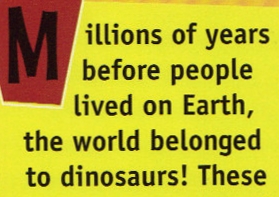 |
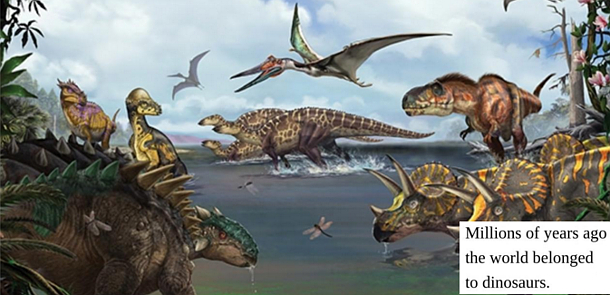
There are countless children's books out there pushing the Evolutionism agenda, but one of the most deceptive things they publish comes from textbooks that pose "critical thinking" questions. Scholastic, one of America's leading teacher/classroom sources, poses a fallacious question to students:
"Why Did All Dinosaurs Become Extinct? "
-Bonnie Sachatello-SawyerDon & Liza Charlesworth, "Why Did All Dinosaurs Become Extinct?" Scholastic, retrieved Mar 22, 2016, [scholastic.com/teachers/article/why-did-all-dinosaurs-become-extinct]
The question itself has built-in assumptions, which is known in logical terms as the 'fallacy of presumption'. It's like asking a man, "Have you stopped beating your wife yet?" If he says yes, he's admitting that he beat his wife, and if he says no, he's admitting to beating he's wife, which leaves an innocent man no honest way to answer the question.
The fallacious question from Scholastic assumes that Evolutionism is true, and it also assumes that dinosaurs are extinct, which is more religious propaganda pushed onto children, effectively brainwashing them. The question is not designed to help children think critically, it is designed to preprogram them on what evolutionists want them to think.
| We should be asking: Did dinosaurs go extinct? |
Just because we haven't seen something, that doesn't prove its non-existence. Granted, I'm not asking one to prove the negative, meaning that I'm not saying that it's up to skeptics to prove dinosaurs don't exist, but my point is that we discover things we didn't know all time, and so to make a giant leap of faith and logic to say that no dinosaurs exist today, with so much of the world undiscovered, is childish to say the least.
The following image is a sea worm that was discovered off the coast of New Zealand that measured out to be 26 feet (8 meters) long. Andrew Buttle, one of the divers who discovered the creature, said:
"Having never seen one in person or even footage or photos of one before, I was quite incredulous [unable to believe] and elated [overjoyed] that such a creature existed. "
![Giant Sea Worm 26 Feet 8 Meters [creationliberty.com]](../images/dino03.jpg)
 (Click for larger view) |
A British man found a 4-foot rat near his home in downtown London:"Engineer Tony Smith discovered the animal's corpse, which he says -Nicholas Reilly, "Huge '4ft-long rat found in children's playground in London'," Metro Mar 11, 2016, retrieved Mar 22, 2016, [metro.co.uk/2016/03/11/huge-4ft-long-rat-found-in-childrens-playground-in-london-5746789] |
Obviously, very large creatures are living right under our noses, but we almost never see them. Later in this teaching, we'll see that even evolutionists themselves have discovered evidence of dinosaur activity, but just like any other cultic religion, the information gets quickly buried once they realize that evidence would destroy the foundations of Evolutionism.
It is impossible to prove the extiction of anything, which is why there are stories that pop up in news articles quite often today in which something is discovered that was previously declared to be extinct. For example, last December (2015) a sea snake declared to be extinct was found to be alive.
(See Discovery News, "Presumed Extinct Sea Snake Reappears Off Australia," Dec 21, 2015, retrieved Mar 22, 2016, [news.discovery.com/animals/endangered-species/presumed-extinct-sea-snake-reappears-off-australia-151221.htm])
Instead of researching to look for evidence, most evolutionists prefer to
(Read "Geologic Column: The Bible of Evolutionism here at creationliberty.com for more details.)
I once heard an evolutionist say, "Beware the sound of one hand clapping," which is a reference to the dangers of propaganda with one side of an argument getting full attention, so in this article, we will explore a more rational look at dinosaurs that typically gets ignored by most media outlets. We will also cover numerous dinosaur and man connections, but most importantly, we'll look at the Biblical perspective the average evolutionist tends to scoff at.
NOTE: Some of the following images are clickable links that will open a new window so you can view a large resolution of the picture for closer inspection.

The evolutionist assumes that dinosaurs, or rather their bones, were first "discovered" around the same time the word was invented, and because of their presuppositional fallacy, they are ignorant of the fact that dinosaurs throughout most of history have been known as 'dragons'. An atheist author on a strictly atheist website writes about why the Bible doesn't mention dinosaurs, and concludes that if the Bible conflicts with Evolutionism, then we have to redefine the Bible:
"[I]f facts firmly established by science seem to contradict the Bible then our interpretation of Scripture must be mistaken. "
-Richard Ostling, "Why doesn't the Bible mention dinosaurs?" Patheos, Jan 19, 2015, retrieved Mar 22, 2015, [patheos.com/blogs/religionqanda/2015/01/why-doesnt-the-bible-mention-dinosaurs]
First of all, I find it hilarious that evolutionists/atheists typically say "science establishes" or "science tells us," because they're giving the abstract term "science" a personification as if it's their god. People establish things, and people tell us things, but science is not a living being. With that in mind, the main problem with this statement is that those things which he believes are "firmly established by science," are actually
It is absurdly stupid to accuse a book of not using a word that was invented thousands of years after the book was written. The dinosaur is talked about in the Bible, but under the historically correct term "dragon:"
Their wine is the poison of dragons, and the cruel venom of asps.
-Deuteronomy 32:33
Thou shalt tread upon the lion and adder: the young lion and the dragon shalt thou trample under feet.
-Psalm 91:13
In that day the LORD with his sore and great and strong sword shall punish leviathan the piercing serpent, even leviathan that crooked serpent; and he shall slay the dragon that is in the sea.
-Isaiah 27:1
"Sixty-five million years ago the dinosaurs died out along with more than 50% of other life forms on the planet."
-Smithsonian National Museum of Natural History, "Why Did They Go Extinct?" retrieved Mar 24, 2016, [paleobiology.si.edu/dinosaurs/info/everything/why.html]
The evolutionists also teach that mankind only appeared in the evolutionary timeline three million years ago, or in other words, man and dinosaur did not exist anywhere near the same time. The problem with this is that any evidence of man and dinosaur living together would destroy the evolutionary timeline, so not only will evolutionists ignore the dragon and dinosaur connection, they will insist that there is no evidence that man and dinosaur ever existed together, or in other words, their presupposition of Evolutionism will cause them to automatically ignore and repress any evidence of dinosaur/man activity.

Although sighting of dragons today are limited, that does NOT automatically prove dinosaurs went extinct during a fictitious period 65 million of years ago. However, popular mainstream Evolutionism sources, like National Geographic, continue to blindly teach:
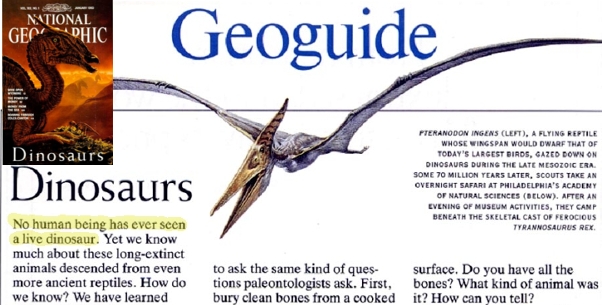
"
There is no possible way the author of this article knows that no human being has ever seen a live dinosaur unless he can be in all places at all times at the same time. Since many of these atheists think they are the gods of their own universe, it is not surprising we would see these kinds of foolish statements. Before jumping to conclusions, let's take a look at the other side to see some evidence of man and dinosaurs living together.
|
This is a palette of slate from the city of Heirakonpolis (Nekhen) that depicts the triumph of King Nar-mer. Nar-mer was the first Pharoah of a united Egypt, and you'll notice two long-necked dragons at the center-piece of the display. Evolutionists will argue that these are just fictional creatures connected to pagan stories, but then they would have accept that the bull (shown below the dragons) is also a fictional creature. (See James B. Pritchard, The Ancient Near East, Princeton University Press, 1969, p. 93; See Also David H. Childress, Technology of the Gods, Adventures Unlimited Press, 1999, p.115, ISBN: 9780932813732; See also Khan Academy, "Palette of King Narmer," retrieved Mar 24, 2016, [khanacademy.org/humanities/ancient-art-civilizations/egypt-art/predynastic-old-kingdom/a/palette-of-king-narmer]) |
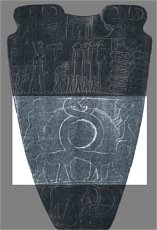 |
It's easy to see the contradictions when long-neck, long-tail creatures like this appear next to lions in ancient artwork. Ishtar Gate, one of the gates to the inner city of Babylon, was constructed by Nebuchadnezzar and depicts long-neck, long-tail dragons right next to clear examples of lions, goats, and bulls.

What's shown in the image below is called a cylinder seal (right), which is like an ancient method of applying wallpaper designs (left). This cylinder seal, which is said to be from Mesopotamia, and located today in the Louvre in Paris, France, depicts long-neck, long-tail dragons entertwined, however, museum officials claim they are just lions. If you take away the presuppositional worldivew, do these look more like lions or dinosaurs?
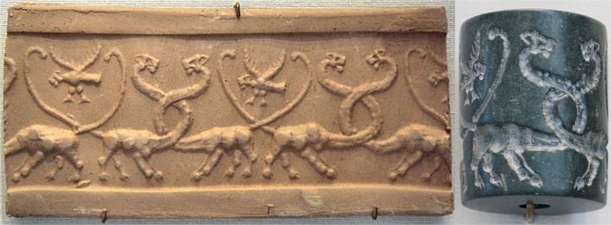
Alexander the Great sought out the dragons worshipped in India, and a number of dragons have been captured and/or killed by various cultures around the world. Onesicritus, a famous Greek historian who traveled with Alexander the Great, documented a number of such cases:
"Onesicritus Astypalaeus writes that there weretwo dragons in India [nurtured by an Indian dancer], one offorty-six [69ft]and the other of eighty cubits [120ft], and that Alexander [the Great] (Philip's son) earnestly endeavoured to see them. It is affirmed in Egyptian books that, during the reign of Philadelphus,two dragons were brought from Ethiopia into Philadelphia alive, one forty [60ft], the other thirty cubits [45ft] in magnitude.Three were also brought in the time of King Evergetis, one nine [13.5ft]and another seven cubits [10.5ft]. The Egyptians say thatthe third was preserved with great care in the temple of Esculapius ... Those who write the history of the affairs of Chios [Greek island; pronounced ki-os] say thata dragon of extreme magnitude was produced in a valley... whosehissing struck the Chians with horror . Asnone either of the husbandmen or shepherds dare, by approaching near, estimate its magnitude, but from its hissing judged it to be a large and formidable beast, at length its size became known by a remarkable accident . For the trees of the valley being struck by a very strong wind, and the branches ignited by the friction, a great fire thence arising, embraced the whole spot, and surrounded the beast, which, being unable to escape, was consumed by the ardour [intense heat] of the flame.By these means all things were rendered visible in the denuded [stripped bare] place, and the Chians freed, from their alarms, came to investigate, and lighted on bones of unusual magnitude, and an immense head, from which they were enable to conjecture its dimensions when living ."
-Onesicritus, quoted by Charles Gould, Mythical Monsters, W.H. Allen & Company, 1886, p. 382, [Library of Catalonia]
The following is a replica of rock art drawings found in a cave near Tanganyika in East Africa. Most people would write this off as some poorly drawn giraffe, until we compare it to other African cave art drawings of a giraffe.
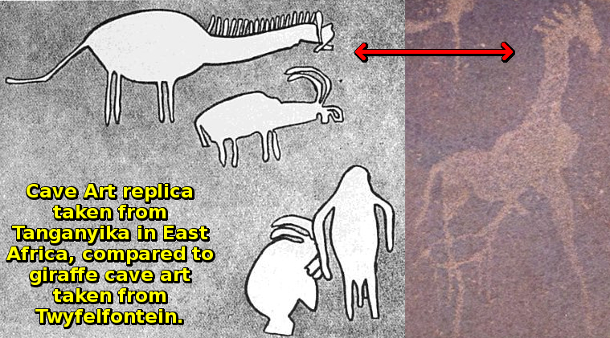
"Kohl-Larsen and his wife gathered a most instructive collection of reproductions ofAfrican cave art during the 1934-36 German African Expedition to the former German colony of German East Africa, present-day Tanganyika. Picture 9 of their book shows, among other things, a strange animal. The Kohl-Larsens write that it reminds one of some kind of mythical animal and note the mane or ridge clearly shown on the back of the long neck. The tail is long and thin, attached to a bulbous body bearing four legs. Again,what it may be we cannot say, except that it definitely is not a giraffe ."
-Roy P. Mackal, A Living Dinosaur? In Search of Mokele-Mbembe, Brill Archive, 1987, p. 8-9, ISBN: 9789004085435; Image (left) from Mackal; Image (right) by Peter Howard, [africanworldheritagesites.org]
Marco Polo, the famous Italian merchant traveler, documented his encounter with the Chinese and dragons:
"Leaving the city of Yachi, and travelling ten days in a westerly direction, you reach the province of Karazon [today, possibly Yunnan], which is also the name of its chief city. The inhabitants are idolaters. The country belongs to the dominion of the grand khan, and the royal functions are exercised by his son, named Kogatin... Here are seenhuge serpents, ten paces [25ft] in length, and ten spans [7.5ft] in the girt of the body. At the fore part, near the head, they have two short legs, having three claws like those of a tiger, with eyes larger than a fourpenny loaf (pane da quattro denari) [the average measuring size of a merchant's standard loaf of bread] and very glaring. The jaws are wide enough to swallow a man, the teeth are large and sharp, and their whole appearance is so formidable, that neither man, nor any kind of animal, can approach them without terror. Others are met with of a smaller size, being eight [20ft], six [15ft], or five paces [12.5ft] long; and the following method is used for taking them. In the day-time, by reason of the great heat, they lurk in caverns, from whence, at night,they issue to seek their food, and whatever beast they meet with and can lay hold of, whether tiger, wolf, or any other, they devour ; after which they drag themselves towards some lake, spring of water, or river, in order to drink. By their motion in this way along the shore, and their vast weight, they make a deep impression, as if a heavy beam had been drawn along the sands. Those whose employment it is to hunt them observe the track by which they are most frequently accustomed to go, and fix into the ground several pieces of wood, armed with sharp iron spikes, which they cover with the sand in such a manner as not to be perceptible. When therefore the animals make their way towards the places they usually haunt, they are wounded by these instruments, and speedily killed. The crows, as soon as they perceive them to be dead, set up their scream; and this serves as a signal to the hunters, who advance to the spot, and proceed to separate the skin from the flesh... [which] is sold at a dear rate, being thought to have a higher flavour than other kinds of meat, and by all persons it is esteemed a delicacy."
-Marco Polo, The Travels of Marco Polo, J.M. Dent & Sons, 1918, p. 246-247, [University of Wisconsin - Madison]
What's really funny about this is that "experts" who analyze Polo's writings have said this was just a crocodile. I've never heard of a crocodile that's known for devouring tigers and wolves, and then has to go visit the river (where they are supposed to live) to get a drink. It's also ludicrous to think Marco Polo, being an experienced explorer, would not have recognized a crocodile or alligator when he saw one, and label it as such in his book. However, the crocodile explanation, against all basic reasoning, must be accepted by those who have faith in Evolutionism to protect the geologic column.
In the 2nd century A.D., the Greek historian Herodotus, who is commonly known today as the "Father of History," documented strange creatures during his travels to the middle-east and nothern Africa.
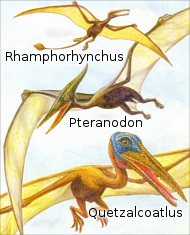 |
What Herodotus documented is often overlooked, but for someone without a religious presupposition of Evolutionism, it is easy to see his description is very close to a pterodactyl:"I went once to a certain place in Arabia, almost exactly opposite the city of Buto, to make inquiries concerning -Herodotus, The Histories, Knopf Doubleday Publishing Group, 2015, p. 160-161, ISBN: 9780375712715 |
It's interesting to note that Isaiah, while writing down the prophecy of the Word of God, also documented the "fiery flying serpent."
The burden of the beasts of the south: into the land of trouble and anguish, from whence come the young and old lion, the viper and fiery flying serpent, they will carry their riches upon the shoulders of young asses, and their treasures upon the bunches of camels, to a people that shall not profit them.
-Isaiah 30:6
"A.D. 793. This year came dreadful fore-warnings over the land of the Northumbrians, terrifying the people most woefully: these were immense sheets of light rushing through the air, and whirlwinds, andfiery dragons flying across the firmament ."
-Ed Lars Ulwencreutz, The Anglo-Saxon Chronicle, Lulu.com, 2013, p. 70, ISBN: 9781409222194
An Irish author described his encounter with a large creature with nails on its tail:
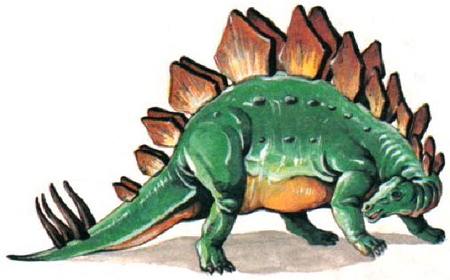
"An Irish writer recorded an encounter witha large beast with 'iron' nails on its tail which pointed backwards. Its head was shaped a little bit like a horse's. And it had thick legs with strong claws. These details match features of dinosaurs like the Kentrosaurus (KEN-tro-SOR-us) and Stegosaurus (STEG-oh-SOR-us). They had sharp-pointed spines on their tails, thick legs, strong claws and long skulls."
-Paul S. Taylor, The Great Dinosaur Mystery, David C. Cook, 1998, p. 43, ISBN: 9780781430715; Image from same source.
The tomb of Richard Bell in a cathedral in Cumbria, England has two dragons carved into brass. Any elementary school student could easily point out a similarity between those drawings and an apatosaurus.

A drawing very similar in shape to an edmontosaurus was discovered on the walls of the Hava Supai Canyon in Arizona.
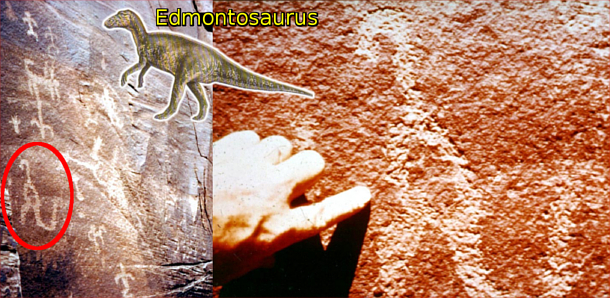
To help further prove the point about the willful blindness of the priests of Evolutionism, let's look at a statement made by the curator of Oakland's archaeology museum:
"The fact that some prehistoric man made a pictograph of a dinosaur on the walls of this canyon upsets completely all of our theories regarding the antiquity of man. Facts are stubborn and immutable things.If theories do not square with the facts then the theories must change, the facts remain. "
-Samuel Hubbard, Charles W. Gilmore & Edward L. Doheny, The Doheny scientific expedition to the Hava Supai Canyon, Northern Arizona: October and November, 1924, Sunset Press, 1925, p. 5
So the strategy of the evolutionist is not to alter their theories to fit the facts, but rather, ignore and misconstrue facts that threaten their theory. Watch what happens when they present this to an evolutionist:
"About a year ago a photograph of the 'dinosaur' was shown toa scientist of national repute, who was then specializing in dinosaurs. He said, 'It is not a dinosaur, it is impossible, because we know that dinosaurs were extinct 12 million years before man appeared on earth.' "
-Samuel Hubbard, Charles W. Gilmore & Edward L. Doheny, The Doheny scientific expedition to the Hava Supai Canyon, Northern Arizona: October and November, 1924, Sunset Press, 1925, p. 9
Why is it impossible to think these drawings we're looking at could be dinosaurs? Because the evolution model gets in the way. The followers of Evolutionism typically show all the signs of any other religious cult in the world, in that their religious beliefs blind them from seeing what's right in front of their faces.
Dennis Fields was a missionary to a tribe of people called the Kuku Yalanji that live in the northern region of Queensland, Australia, and he asked them to draw a picture of the creature they described living in the water near their home:
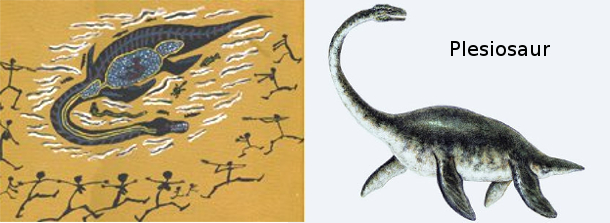
"The tribal artist, with very little formal education, hadno knowledge of what so-called prehistoric animals looked like , and was drawing only from the descriptions handed down in the ancient stories. The paintingshows a creature with a remarkable resemblance to the extinct plesiosaurus ."
-Rebecca Driver, "Australia's Aborigines... Did They See Dinosaurs?" Answers in Genesis, Dec 1, 1998, retrieved Mar 29, 2016, [answersingenesis.org/dinosaurs/humans/australias-aborigines-did-they-see-dinosaurs]; The drawing (left) was donated to Answers in Genesis; We at CLE do not endorse AiG due to their leaven.
After 16th century Spanish conquistadors ruthlessly slaughtered regions of South America looking for treasure and glory, they found stones in Peru with strange creatures carved into them:
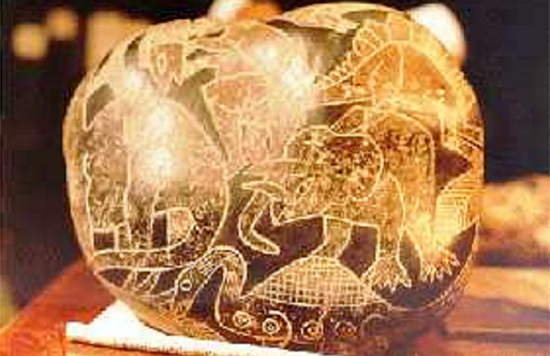
"The first mention of the stones is from a Spanish priest journeying to the region of Ica in 1535. Father Simon, a Jesuit missionary, accompanied Pizarro along the Peruvian coast andrecorded his amazement upon viewing the stones. In 1562, Spanish explorers sent some of the stones back to Spain ."
-Dennis Swift (owner of the largest collection of Ica stones in the world), Secrets of the Ica Stones and Nazca Lines, David Swift, 2006, p. 16-17; See also Cientifico Descubre Dinosaurios en Ica [Scientists Describe Dinosaurs in Ica], Ojo-Lima, Sunday, October 3, 1993, p. 7
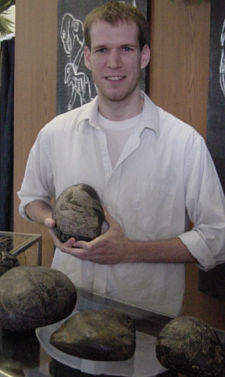 |
I am fully aware of all the scoffing atheists and evolutionists out there who claim the stones of Ica are fake, but I've personally been to the largest collection of Ica stones in the U.S., which is located in Pensacola, Florida, and seen them for myself. There are certainly fakes and frauds of these stones out there, no question, but that does not automatically disprove the real ones, as a number of scientists have done studies concerning the ages of these stones.
The stones are extremely dense and heavy, leaving us to wonder how they carved such precise lines in them in the first place. However, the most important thing to note is that there is a very fine, microscopic patina (oxidation coating) in the carved lines of the stones that require hundreds of years for accumlation, which conclusively proves the stones I'm showing in the images here are real, and that these men must have seen these creatures alive, especially since they depict men killing them (see below). (Read "Are the Ica Stones Fake or Real?" here at creationliberty.com for more references and details on the Ica stones.) |
"The stones are covered with a fine patina of natural oxidation which also covers the grooves by which their age should be able to be deduced. I have not been able to find any notable or irregular wear on the edges of the incisions which leads me to suspect thatthese incisions or etchings were executed not long before being deposited in the graves or other places where they were discovered ."
-Dr. Eric Wolf (geologist), Lima, Peru, June 8, 1967, from lab testing of 33 Ica stones requested by Dr. Javier Cabrera to Luis Hochshild, Secrets of the Ica Stones and Nazca Lines, David Swift, 2006, p. 19
Also consider these stones were reported in the 16th century. Are we expected to believe that people 500 years ago anticipated the teaching of Evolutionism and hid these stones in the ground just to trick mankind in some conspiracy?
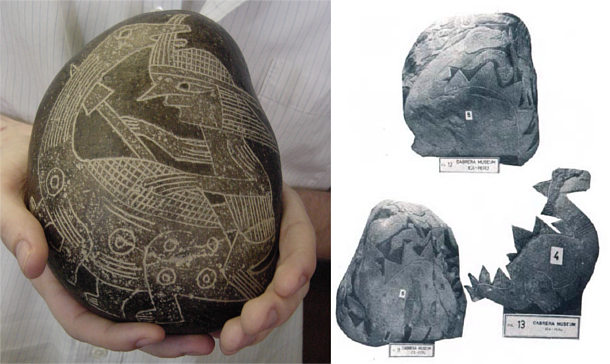
What gets even more fascinating are the strange circular rosetta patterns the natives of Ica were drawing on these dragons. The image above has a circle within a circle, and quite a few of them; many Ica stones contain these rosetta patterns. The Creation Evidence Museum in Glen Rose, Texas, displays fossilized dinosaur skin with circular rosetta patterns on it, just as the Icas depicted on their stones.
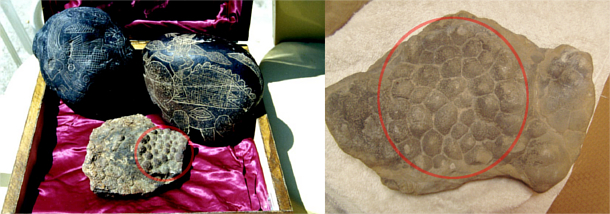
There is no way the Ica peple would have known to draw those on the skin unless they had seen the creatures alive. However, National Geographic continues to brainwash readers by insisting:
"No human being has ever seen a live dinosaur. "
-National Geographic, "Dinosaurs," January, 1993, Vol. 183, No. 1, p. 147
Not only is there no possible way that author could know such a thing, but thousands of pieces of evidence are getting buried in a desperate attempt to protect the holy sacred cow of Evolutionism. We'll get into more evidence of dinosaur activity later, but let's first take some time to look at the Biblical worldview.
"Creationists realize that the ark had a limited amount of room and they are aware of the large number of species in the animal kingdom. Therefore,they have employed various tactics to reduce the population needed on board . Probably the mostimportant tactic is to restrict the command to 'kinds' rather than species and to argue that the former are much fewer in number than the latter."
-Robert A. Moore, "The Impossible Voyage of Noah's Ark," National Center for Science Education, retrieved Mar 29, 2016, [ncse.com/cej/4/1/impossible-voyage-noahs-ark]
They present this as a conspiracy, as if some sort of priesthood came in and changed the Word of God to say "kind," the Bible has never used the word 'species'. First, the preserved Word of God in the King James Bible has had the term 'kind' in it for over 400 years, which is a Biblical term used by the Lord God over the past 6,000 years in Scripture, or in other words, no one suddenly "realized" a contradiction and changed what words were used. What the evolutionary fanatics quickly ignore is that even Charles Darwin used the term 'kind' in his Origin of Species many times.
(Read "What is a Biblical Kind?" here at creationliberty.com for more details and references.)
Furthermore, in a live creation/evolution debate, Dr. William Moore, 35-year veteran professor of biology who had attended conferences on the subject of defining what a species is, was asked if he could define it. He said:
"This is my area of research, and to be honest with you, I don't know. "
-Dr. William Moore, 35-year tenured evolutionary biology professor at Wayne State University, creation/evolution debate at Wayne State University, Sept 24, 1998
The fact of the matter is that evolutionists CLAIM to know what a species is, but once we investigate their claims, we find it's extremely vague and can be interpreted a number of ways. For example, a dog, wolf, and coyote are all classified as different species, but yet they are all interfertile (i.e. they can mate and bring forth offspring), which contradicts most of the definitions of species available in biology textbooks.
(Read "Evolutionism: A New-Age Religion -- What is a Species?" here at creationliberty.com for more details.)
Not only do they not know what a species is, the typical evolutionist doesn't even know how large Noah's Ark was; they only claim that the task impossible because they have a religious presupposition they have to protect. The Ark was approximately 2/3rds the size of the Titanic. (300x50x30 egyptian cubits = 450,000 cubic feet) Also taking into consideration that there were no lavish ballroom, dining halls, 1st-class accomodations, or engine rooms, meaning this was not a luxury cruise ship, and was designed specifically for the purpose of storing a large number of animals and supplies for about a year, then we can see the task was easily in the realm of reality for those of us that are not blinded by cultic presuppositions.
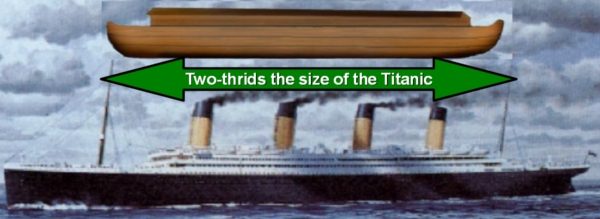
In a live debate, Bill Nye (known as the "science guy," but is really just another priest for Evolutionism) compared Noah's Ark to large wooden ship called the Wyoming:

"People in the early 1900s built an extraordinarily large wooden ship, the Wyoming. It was asix-masted schooner , the largest one ever built, and ithad a motor on it, for winching and cables and stuff. But this boat had a great difficulty. It was not as big as the Titanic, but it was a very long ship. It would twist in the sea. It would twist this way [acting out the first torsional mode], this way [first vertical bending mode], and this way [first horizontal bending mode]. With all that twisting, it leaked, and it leaked like crazy. The crew could not keep the ship dry. And indeed,it eventually foundered [filled with water] and sank , and theloss of all 14 hands . So there were 14 crewmen aboard a ship built by very skilled shipwrights in New England.These guys were the best in the world at wooden shipbuilding , and they could not build a boat as big as the Ark is claimed to be to have been. Is that reasonable? Is that possible? That thebest shipbuilders in the world could not do what eight unskilled people, men and their wives, were able to do ?"
-Bill Browning, "Transcript of Ken Ham vs Bill Nye Debate," Feb 4, 2014, retrieved Apr 5, 2016, [youngearth.org/index.php/archives/rmcf-articles/item/21-transcript-of-ken-ham-vs-bill-nye-debate]
Nye asks if this is reasonable? Let's find out how "reasonable" Nye is:
|
|
When Ken Ham first announced the debate, I told people I didn't want to watch it because I knew exactly what it was going to be: a useless media stunt. It was only something to help Ken Ham get more exposure on TV because he's a marketer, not a minister. Ham didn't give any proper answers to the challenges being presented to him, and Nye just kept pushing his religious dogma, so I don't recommend wasting your time on it. I made many predictions about what was going to happen during the debate, and almost all of them were correct. Although I didn't want to see the debate, a number of people asked me for an analysis of it, so I ended up doing a four-hour podcast review of the debate, and if you want to watch it, click this link: Ham/Nye Debate: Useless Media Stunt |

Simple additions make sense, but even if that was not the case, the boat itself was protected by God Himself. There is no way that boat was going to break under any circumstance because the Spirit of God was in the ark with Noah and his family, which is why He told Noah to "come" into the ark, instead of "go" into the ark.
And the LORD said unto Noah, Come thou and all thy house into the ark; for thee have I seen righteous before me in this generation.
-Genesis 7:1
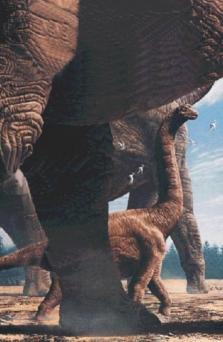 |
Of course, there is a lot more we could discuss concerning Noah's Ark, but turning back to the topic at hand, despite how large the Ark was, how would someone keep dinosaurs on it? The dimensions of some adult dinosaurs would certainly not fit on Noah's Ark, but the Lord God did not tell Noah to go out into the world and find the biggest ones. It's much easier to bring younglings, and there are many logical reasons for it:
|
Some folks may be concerned that the animals, over the course of 13 months (the amount of time they were in the boat), would grow too large, but large animals take a lot of time to reach maturity. Elephants, for example, don't reach full adulthood age until they're about 18 years old, and they're not even weaned from their mother's milk until 3-5 years of age.
(See Elephants Forever, "Elephant Life Cycle," retrieved Apr 6, 2016, [http://www.elephantsforever.co.za/life-cycle.html])
Other folks may be concerned about having meating eating dinosaurs, and no meat to eat, and how they would attack the people and other animals on the boat, but nothing ate meat until after the flood when God allowed it, and there was no fear and dread of man until after the flood:
And the fear of you and the dread of you shall be upon every beast of the earth, and upon every fowl of the air, upon all that moveth upon the earth, and upon all the fishes of the sea; into your hand are they delivered. Every moving thing that liveth shall be meat for you; even as the green herb have I given you all things.
-Genesis 9:2-3
However, this does leave us with an interesting question: After the dinosaurs got off the Ark, what happened to them?
Go forth of the ark, thou, and thy wife, and thy sons, and thy sons' wives with thee. Bring forth with thee every living thing that is with thee, of all flesh, both of fowl, and of cattle, and of every creeping thing that creepeth upon the earth; that they may breed abundantly in the earth, and be fruitful, and multiply upon the earth. And Noah went forth, and his sons, and his wife, and his sons' wives with him: Every beast, every creeping thing, and every fowl, and whatsoever creepeth upon the earth, after their kinds, went forth out of the ark.
-Genesis 8:16-19
(Read "The Pre-Flood World" here at creationliberty.com for more details.)
For example, an apatosaurus, which has been found fossilized as tall as 80ft, only has nostrils the same size as a horse, and in today's atmospheric conditions, it would not be able to get enough oxygen to live. A creature of that magnitude needs enormous amounts of oxygen per breath, and in the pre-flood world atmosphere, that would not have been a problem, but for evolutionists, it's a big problem. Some dedicated followers of Evolutionism are slowly beginning to understand this:
" -Associated Press, "Death of dinosaurs linked to lack of oxygen," The Tuscaloosa News, Oct 27, 1993, p. 5a |
 |
Putting all that aside, I believe the number one reason most dinosaurs today have been killed off is because of mankind, and for many reasons:
(See Marco Polo, The Travels of Marco Polo, J.M. Dent & Sons, 1918, p. 246-247, [University of Wisconsin - Madison])
| This does not mean that all dragons were hunted and killed to the point of extinction; it just means that we don't typically see them much anymore because they have had retreat into secluded places. |
Another point to consider about why we don't see dragons today is that reptiles never stop growing, but due to a reduced atmosphere, limited food supply, limited living locations (due to mankind spreading out), and other factors like radiation (again, see "The Pre-Flood World" for more details), they don't grow as big as they used to be. If an animal that never stops growing can be left alone and survive long enough, obviously, it will keep growing and become very large.
One of the first recorded dinosaurs discoveries that evolutionists are willing to talk about was concerning a giant fossil found by George Mantell:
"[Mantell] was convinced that he had found fossils ofa large, extinct, herbivorous reptile . Impressed by the similarity of the fossil teeth to those of the living iguana,he named the fossil creature Iguanodon: 'iguana-tooth.' "
-Keith M. Parsons, The Great Dinosaur Controversy: A Guide to the Debates, ABC-CLIO, 2004, p. 20, ISBN: 9781576079225
Mantell saw that the teeth looked exactly like those of an iguana, but they were enormous. If we give a reptile perfect living conditions, give it a few decades, and it can grow to surprising sizes. Although a typical evolutionist gives off the impression they know everything there is to know, many people are unaware of giant creatures still living in many secluded parts of the world today.
An Indonesian zoo put on display the longest snake in captivity:
"Hundreds of people have flocked to see the snake at a primitive zoo in Curugsewu village on the country's main island of Java. Local government official Rachmat saidthe reticulated python measured 48 feet 8 inches and weighed in at 983 pounds ."
-Associated Press, "49-foot python captured in Indonesia," NBC News, Jan 8, 2004, retrieved Apr 7, 2016, [nbcnews.com/id/3845750/ns/world_news/t/-foot-python-captured-indonesia/#.VwaZ3_krKUk]
 |
British army Colonel Percy Fawcett was sent to South America in 1907 to settle a quarrel over boundaries between Brazil, Peru, and Bolivia. While making their way up the river, Fawcett and his crew caught sight of something they didn't expect: |
"According to Fawcett's report, he and his crew were slowly making their way up a remote jungle river in a dugout canoe. Suddenly, they were startled by the sight of the huge head of a monstrous snake passing beneath their boat. The snake swam ashore and started to make its way up the riverbank. Fawcett saw that |
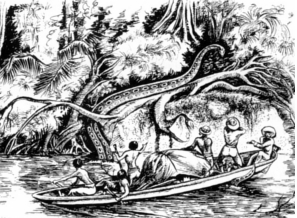 |
Fawcett ordered his terrified crew to paddle ashore so they could get a close look at the beast. As best he could guess--because part of the snake's tail was in the water and out of reach--the anaconda was an amazing 62 feet (19 m) long . To obtain evidence to back up his story, Fawcett tried to cut off a piece of the snake's skin; but the injured animal was still alive and wiggling. Fawcett was unable to approach close enough to slice off a skin sample."
-Rick Emmer, The Giant Anaconda and Other Cryptids: Fact or Fiction?, Infobase Publishing, 2010, p. 15-17, ISBN: 9781438132846; See also Geoff Barton, The Real World: Non-fiction and Media, Heinemann, 1998, p. 5, ISBN: 9780435101183
The Brazil Columbia Commission killed a snake weighing over two tons (4,000 lbs):
"The officials of the Brazil-Columbia Boundary Commission... in 1933... killed a98 ft. (30m) snake 2 feet in diameter with a machine gun on the banks of the Rio Negro... Four men had been unable to lift its head."
-Bernard Heuvelmans, On the Tracks of Unknown Animals, R. Hart-Davis, 1958, p. 296, [University of Michigan]
Some of you may be thinking why more evolutionists, since they seem to always claim an interest in science and biology, would not want to more deeply investigate these claims. The problem is that giant snakes, such as those we just documented, go against the geologic column (the Bible of Evolutionism) because they claim such giant snakes lived 58 million years ago.
(See Jane O'Brien, "The giant snake that stalked the Earth," BBC News, Apr 2, 2012, retrieved Apr 7, 2016, [bbc.com/news/magazine-17544885]; See also "Geologic Column: The Bible of Evolutionism" here at creationliberty.com for more details.)
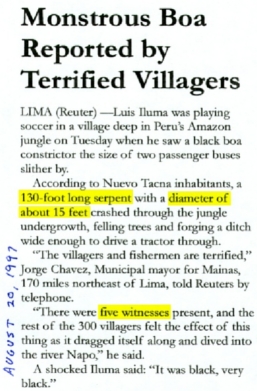 |
Any discovery of a living creature that is said by the geologic column to be extinct is (in most cases) immediately rejected as fraudulent. This is done not because of research and investigation, but because of zealots who work tirelessly to protect their religious dogmas.
Because of this, news reports of a snake the size of a bus gets buried in the media: "[He] saw a "There were five witnesses present, and the rest of the 300 villagers felt the effect of this thing as it dragged itself along and dived into the river Napo," (See Reuters News Service, "Monstrous Boa Report by Terrified Villagers," Aug 20, 1997; See also Fortean Times, Issues 102-106, John Brown Publishing, 1997, p. 18) |
Although fresh water crocodiles are claimed not to grow much longer than 17ft, the Congolese tribesmen have reported crocodiles that can grow around 50ft:
"Mahamba is the name applied in the Democratic Republic of Congo to a supposed 50-ft. crocodile... |
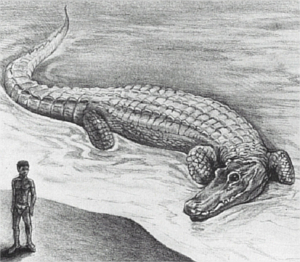 |
As we can see, there are still giant reptiles roaming the earth. Before we get into some dragon sightings, let's look at the Bible's descriptions of dinosaurs.
Behold now behemoth, which I made with thee; he eateth grass as an ox.
-Job 40:15
Lo now, his strength is in his loins, and his force is in the navel of his belly.
-Job 40:15
The Amplified (new-age) Bible adds in parenthesis that it's a hippo:
"Behold now the behemoth (the hippopotamus), which I created as I did you; he east grass like an ox."
-Job 40:15, The Amplified Bible, Zondervan, 1987
The NASB has a footnote next to "Behemoth" that says "or, the hippopotomus."
-Blue Letter Bible, The New American Standard Bible, retrieved Apr 7, 2016, [blueletterbible.org/niv/job/40/1/t_bibles_476015]

The interesting thing about the NIV is that years ago, I knew that they had tried to keep quiet all the numerous changes that had, and continued to make to the NIV, so I took a screen shot of it back in 2011 when I first wrote this. I went back to check for it more recently (2016), and that foot note has been removed from the source I got it from. I checked a few other sources, and could no longer find this NIV footnote; so why would that be?
I suspect what is happening is that the creation movements are picking up so much momentum and are so popular among American church buildings right now, the NIV publishers are willing to abandon their footnotes. Many people might find this insignificant, but I disagree strongly. What they're doing is changing how they interpret God's Word based on what's popular, and they'll just go whichever way the wind is blowing so people will buy more of their published works. (i.e. If their footnote might create a controversy that would put a kink in their sales, they'll appease the crowd.)
(Read "Why I Use the King James Bible" here at creationliberty.com for more details.)
That we henceforth be no more children, tossed to and fro, and carried about with every wind of doctrine, by the sleight of men, and cunning craftiness, whereby they lie in wait to deceive;
-Ephesians 4:14
He moveth his tail like a cedar: the sinews of his stones are wrapped together.
-Job 40:17

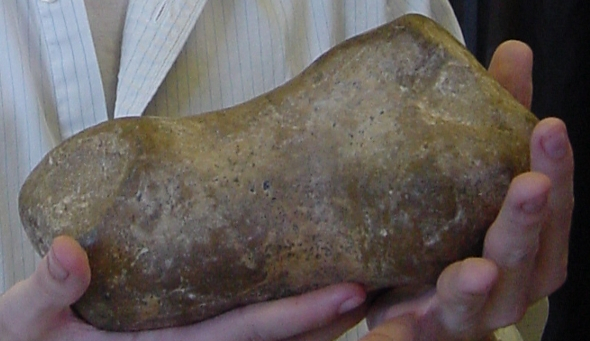 |
His bones are as strong pieces of brass; his bones are like bars of iron. -Job 40:18 This photo is a picture of me holding a brachiosaurus toe bone. It was extremely dense and heavy; a dragon of this magnitude could easily kill (step on) a man without knowing it. |
He is the chief of the ways of God: he that made him can make his sword to approach unto him.
-Job 40:19
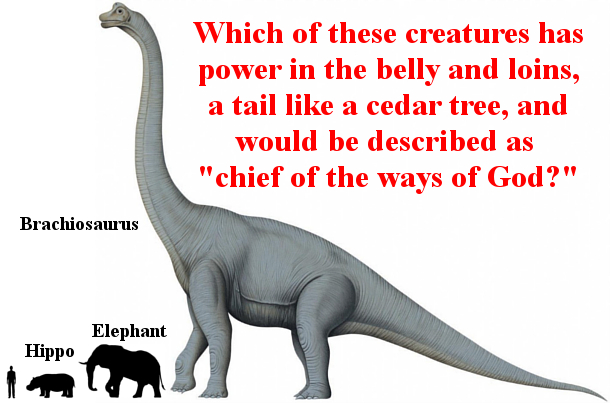
Speaking of fearing to raise a sword against something, another creature called "Leviathan" is mentioned in Scripture as well. Let's look closely at the description:
Canst thou draw out leviathan with an hook? or his tongue with a cord which thou lettest down? Canst thou put an hook into his nose? or bore his jaw through with a thorn?
-Job 41:1-2
Wilt thou play with him as with a bird? or wilt thou bind him for thy maidens?
-Job 41:5
Behold, the hope of him is in vain: shall not one be cast down even at the sight of him? None is so fierce that dare stir him up: who then is able to stand before me?
-Job 41:9-10
Who can discover the face of his garment? or who can come to him with his double bridle?
-Job 41:13
Who can open the doors of his face? his teeth are terrible round about. His scales are his pride, shut up together as with a close seal. One is so near to another, that no air can come between them. They are joined one to another, they stick together, that they cannot be sundered.
-Job 41:14-17
By his neesings [sneezing] a light doth shine, and his eyes are like the eyelids of the morning. Out of his mouth go burning lamps, and sparks of fire leap out. Out of his nostrils goeth smoke, as out of a seething pot or caldron. His breath kindleth coals, and a flame goeth out of his mouth.
-Job 41:18-21

In his neck remaineth strength, and sorrow is turned into joy before him. The flakes of his flesh are joined together: they are firm in themselves; they cannot be moved. His heart is as firm as a stone; yea, as hard as a piece of the nether millstone. When he raiseth up himself, the mighty are afraid: by reason of breakings [terror of his mighty destruction] they purify themselves. [i.e. they prepare to meet their Maker] The sword of him that layeth at him cannot hold: the spear, the dart, nor the habergeon.
-Job 41:22-26
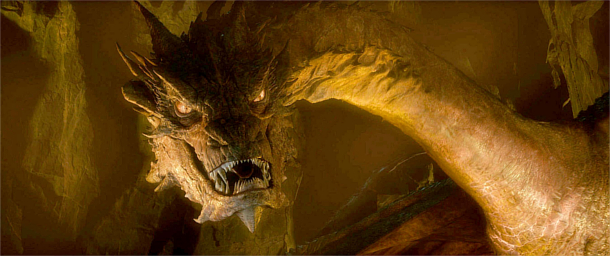
He esteemeth iron as straw, and brass as rotten wood. The arrow cannot make him flee: slingstones are turned with him into stubble. Darts are counted as stubble: he laugheth at the shaking of a spear... He maketh the deep to boil like a pot: he maketh the sea like a pot of ointment. He maketh a path to shine after him; one would think the deep to be hoary. Upon earth there is not his like, who is made without fear.
-Job 41:27-33
Earlier, I quoted the Anglo-Saxon Chronicles, and let's read it one more time:
"A.D. 793. This year came dreadful fore-warnings over the land of the Northumbrians, terrifying the people most woefully: these were immense sheets of light rushing through the air, and whirlwinds, andfiery dragons flying across the firmament ."
-Ed Lars Ulwencreutz, The Anglo-Saxon Chronicle, Lulu.com, 2013, p. 70, ISBN: 9781409222194
The evolutionary position is always to assume that ancient man was nothing but a bunch of stupid savages, and modern man is smart and sophisticated. Granted, there were many pagans then as there are today, but to think that these men could have simply wrote down the things they were seeing with their own eyes is a threat to Evolutionism because it contradicts the timeline of their religion.

(See Reddit: Ask Historians, "Why is the dragon the only mythological creature on the Chinese zodiac?" Mar 11, 2015, retrieved Mar 24, 2016, [reddit.com/r/AskHistorians/comments/2yqc5t/why_is_the_dragon_the_only_mythological_creature])
After what we've just read in the Word of God, I don't believe the last one is mythological; I believe the dragon is also real, just as dinosaurs are real. However, most evolutionists refuse to look at or even consider any evidence which violates their preconceived religious worldview.
He lieth under the shady trees, in the covert of the reed, and fens.
-Job 40:21
covert (adj): covered, hid, private, secret, concealed
reed (n): common name of many aquatic plants; large grasses, bamboo
fen (n): low land overflowed or covered partially with water, producing coarse grasses or other aquatic plants; boggy land or marsh
(See 'covert', 'reed', & 'fen', American Dictionary of the English Language, Noah Webster, 1828, retrieved Apr 13, 2016 [webstersdictionary1828.com])
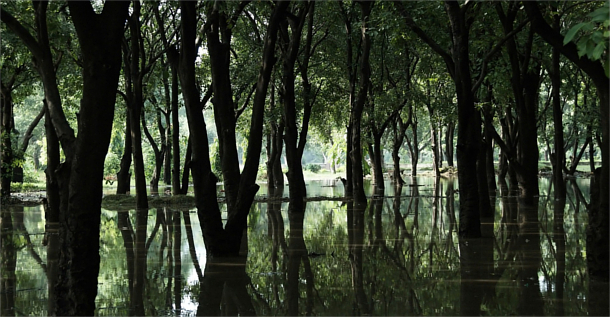
 |
"Reports of -Marc Miller, Far-Out Adventures: The Best of World Explorer Magazine, Adventures Unlimited Press, 2001, p. 21, ISBN: 9780932813794 |
|
The first swamp region we will cover is the largest in the world located in the Congo jungle in Africa. The Likouala Swamp is roughly the size of the state of Alaska, and consists of deadly marsh terrain that remains mostly unexplored territory today because the environment is so harsh.
Herman Regusters, a former U.S. Air Force pilot with college degrees in physics, business law, and psychology, and who has worked for ITT, General Electric, and the Goddard Space Center with his expertise in digital and analog equipment design, went on an expedition into the Likouala Swamp with his wife Kia. Their efforts greatly improved former French maps of the area. Most people in countries outside of Africa don't have a good understanding of how dangerous the swamp is in the Congo, so let's look at Regusters' description to get a better idea: |
 |
"Giant woody vines, or lianas, are suspended from the tall trees, and dense thickets of shrubs and smaller vines createan almost impenetrable mass . In addition, the trees are supported on massive aerial root systems that contribue further to the formidability...water depths in the swamp varied from a few centimeters to a several meters. These waters, dyed red from the iron and aluminum deposits in a soil that has been leached of silica, represented oursole source of water for all uses .
For the five days of our trek through the forest to the lake (and on the return),we remained completely wet . In the evenings, our small tents were erected on beds of leaves that had accumulated over the years on the great aerial roots of the tall trees. This meant we had to locate an adequate 'island' before dark. Consequently, our day began at 4:30 in the morning and continued until 4:00 in the afternoon. In the forest, we werealways besieged by swarms of sweat bees (African killer bees) whenever we halted to camp...
On the fifth day of our march the 'Boa ramp' disappeared, withinthree kilmoeters of the lake.Walking in water that was often chest deep, we required more than six hours to negotiate the final distance ."
-Herman A. Regusters, Mokele-mbembe: An Investigation Into Rumors Concerning a Strange Animal in the Rupublic [i.e. Republic] of the Congo, California Institute of Technology, 1982, p. 9, ISSN: 0047-8350
The average, healthy, exercised individual, which the Regusters would have been, can walk three kilometers in less than 30 minutes. Due to the harsh environment in Likouala, 30 minutes of walking distance turns into six hours. Slow moving for days while completely soaked, little or no place for camping or cooking, while dodging the dangerous animals and insects of the Congo, this sounds like the perfect "covert" spot for the behemoth to live.
"Regusters, a 47-year-old consulting engineer, left for the Congo in September. He spent several weeks in its captical city of Brazzaville before taking his party about 500 miles farther into the jungle to the Lake Tele area, where most of the sightings of 'mokele-mbembe' have been reported. Regusters said before leaving thatnatives have long reported sighting the creature , thought possibly to be a survivor ofa dinosaur species believed extinct for 60 million years . The creature was 'dark brownish in color, the skin appeared slick and smooth, with a long neck and small head ,' [John] Sack [friend of Regusters who has handled details of the expedition] reported. 'Because of the long neck, it was not a hippo or elephant.It was no animal known to any of the people on the expedition. Many members of the expedition had seen the creature and heard it making noise , he said."
-Associated Press, "Dinosaur hunters back home," Southeast Missourian, Dec 22, 1981, p. 10
Although I was not able to find the original source of this news article, they published a few more details from the Associated Press:

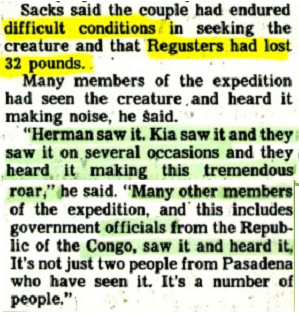 |
"'Herman saw it. Kia saw it and they saw it on several occasions and they heard it making this tremendous roar,' he [John Sack; expedition coordinator] said. 'Many other members of the expedition, and this includes |
Based on my understanding of the situation, the photographs Herman and Kia took of the creature did not turn out well because the film was corrupted in the harsh swamp conditions. Getting film or digital equipment into the depths of the Congo, and bringing them out in good condition afterwards, is a task easier said than done. However, the Regusters did manage to get an audio recording of the creature, which you can listen to here:
(See Iarissalurid, "HELP! Boa making popping/cracking sound?!" TeguTalk, May 10, 2012, retrieved Apr 13, 2016, [tegutalk.com/threads/help-boa-making-popping-cracking-sound.11337]; See also "My baby corn snake is making a popping sound," Just Answer - Reptile Vet, retrieved Apr 13, 2016, [justanswer.com/pet-reptile/44t2m-baby-corn-snake-making-popping-sound-no-mucus.html])
Long before Regusters went on his expedition, other explorers and missionaries were coming back with the similar reports of a monstrous creature:
"The missionaries have observed in passing along a forest,the track of an animal which they have never seen ; but it must be monstrous, the prints of its claws are seen on the earth, and formed an impression on it ofabout three feet in circumference . In observing the Posture and disposition of the footsteps, they concluded that it did not run in this part of its way, and thatit carried its claws at the distance of seven or eight feet one from the other ."
-Abbe Lievain Bonaventure Proyart, History of Loango, Kakonga, and other Kingdoms in Africa, 1776, translated by John Pinkerton, A General Collection of Voyages and Travels, 1814, p. 557, [Oxford Univserity]
These reports are from the late 19th to early 20th centuries:
"Some years ago I received reports from two quite distinct sources of the existence of an immense and wholly unknown animal, said to inhabit the interior of Rhodesia.Almost identical stories reached me , firstly, through one of my own travellers, and, secondly, through an English gentleman, who had been shooting big-game in Central Africa.The reports were thus quite independent of each other , and, as a matter of fact, the Englishman and my traveller had made their way into Rhodesia from opposite directions, the one from the north-east and the other from the south-west. The natives it seemed, had told both my informants thatin the depth of the great swamps there dwelt a huge monster, half elephant, half dragon. This, however, is not the only evidence for the existence of the animal. It is now several decades ago since Menges, who is of course perfectly reliable, heard a precisely similar story from the negroes; and, still more remarkable, on the walls of certain caverns in Central Africa there are to be found actual drawings of this strange creature.From what I have heard of the animal, it seems to me that it can only be some kind of dinosaur, seemingly akin to the brontosaurus. As the stories come from so many different sources, and all tend to substantiate each other, I am almost convinced that some such reptile must be still in existence. At great expense, therefore, I sent out an expedition to find the monster, but unfortunately they were compelled to return home without having proved anything, either one way or the other. In the part of Africa where the animal is said to exist,there are enormous swamps, hundreds of sqaure miles in extent, and my travellers were laid low with very severe attacks of fever. Moreover, that region is infested by bloodthirsty savages who repeatedly attacked the expedition and hindered its advance. "
-Carl Hagenbeck & Hugh S.R. Elliot, Beasts and Men, Being Carl Hagenbeck's Experiences for Half a Century Among Wild Animals, Green Longmans, 1911, p. 96-97, [University of California]
"He submitted to them [i.e. the natives] sketches and pictures, some of prehistoric monsters taken from the geology books; others from his own imagination, and yet others which represent composite types of all the strange creatures in the sea or on the earth which now are or ever were.The Africans substantially agree on one description. What they have seen, as they put it, has the head and tail of a crocodile, the horns of a rhinoceros, the neck of a python and the body of a hippopotamus, 'and it propels itself with flappers.' They vary in their statments concerning the length of a creature whose body they have seen in the water, but from what they say it may measure anywhere fromtwenty-five to fifty feet . Those who have talked with two men who declare they have seen such a monster areimpressed by their straight-forward manner and the complete absence of any motive for exaggeration ."
-The New York Herald, "Is a Brontosaurus Roaming Africa's Wilds?" Feb 13, 1910, p. 1
The absurdities of evolutionary presuppositions with heavy reliance on the fictional geologic column was as much of a problem 100 years ago as it is today. The newspaper continues to document an evolutionary paleontologist's repsonse to the suggestion that this water creature very aptly fits the description of a plesiosaur:
"I have seen it hinted that this may be a surviving plesiosaurus or some descendant of that race which has been preserved through all the ages and permitted to flourish in Africa unmolested.This I believe for many reasons to be absolutely impossible. The plesiosaurus disappeared from this earth four millions of years ago as nearly as we can now determine. "
-The New York Herald, "Is a Brontosaurus Roaming Africa's Wilds?" Feb 13, 1910, p. 2
The evolutionist goes on to explain they were just hallucinating some crocodile they didn't recognize. What's amazing is that those natives who live and survive in the harsh conditions of the swamp, who can recognize crocodiles, hippos, and other local creatures, and an accomplished animal trainer (Hagenbeck), who is an expert on wild animals and their behavior, suddenly become complete morons and mentally insane in the eyes of an evolutionist who clings desperately to his religious dogma.
The typical evolutionist writes off these eye-witness testimonies as just hallucinations, like this editor says about Regusters:
"He never actually said he thought he had seen and heard a dinosaur. He is far too competent a scientist for that...This editor does not believe that a dinosaur was seen or that one exists... Along with most scientists I believe that [testimony of sightings] are frauds or hallucinations. "
-Ned Munger, Munger Africana Library Notes (Preface to Rugusters' Book), California Institute of Technology, 1982, p. 2, ISSN: 0047-8350
There is a small willingness to accept the discovery of a new creature by some evolutionists, but as for most Evolutionism fanatics (who call themselves "scientists"), they are absolutely against a discovery of a "dinosaur." Why is that so hard to believe, that a dinosaur could be alive today? The priority for evolutionists is to protect their sacred geologic column (the Bible of Evolutionism), which says it can't be a dinosaur, and they are willing to throw out their so-called scientific minds and openness to discovery in order to protect their religious paradigm.
However, for those of us who aren't blinded by religious presuppositions, we can fearlessly analyze testimonies of African expeditions, and the description of a creature known as "Mokele-Mbembe." Leo von Boxberger, a magistrate in Germany's African colonies before World War I, wrote about the data he collected about a water beast from the locals:
"My own contribution to the subject is unfortunately very small. At the mouth of the Mbam in Sanaga in central Cameroons [German colonies in Africa in the early 20th century] and on the Ntem in Southern Cameroons, I collected a variety of data from the natives about the mysterious water-beast, but alas, all my notes and also the local description of the animal were lost in Spanish Guinea when the Pangwe attacked the caravan carrying my few belongings. All that I can report is the name mbokalemuembe given to the animal in Southern Cameroons... The belief ina gigantic water-animal described as a reptile with a long thin neck , exists among the natives throughout the Southern Cameroons, wherever they formpart of the Congo basin and also to the west of this area, doubtless wherever the great rivers are broad and deep and are flanked by virgin [old, undisturbed] forest ."
-Bernard Heuvelmans, On the Track of Unknown Animals, R. Hart-Davis, 1958, p. 462, [Univserity of Michigan]
Eugene and Sandy Thomas (who are now deceased) were Christian missionaries in the Congo, and had a lot of interaction with the pygmy tribes around the Likouala Swamp. Before she died, I spoke with Sandy over the phone (she lived in Warren, Ohio at the time), and she confirmed for me that her and her husband had met two local pygmies in 1959 that had killed a Mokele-Mbembe. She also confirmed for me that they both had seen the tracks of this creature, but had no plaster of paris to create a mold of it to bring back. If you want more details of their missionary experience in Africa, Sandy wrote a book called Beyond Jungle Walls.
(Sandy Thomas, Beyond Jungle Walls: Bringing Hope to the Forgotten Congo, 21st Century Press, 2005, ISBN: 9780976624356)
I'll take it one step further than Mackal, from the evolutionary presupposition, to ask: Why couldn't a dinosaur-like creature evolve in the Congo over the past few million years? If a dinosaur was caught and put on display at a zoo, evolutionists would not be converted; they would simply explain it to be an evolved creature. They don't believe in Evolutionism based on evidence. These evolutionists/atheists know that a dinosaur being alive today is strong indication the Bible is true, and the real reason they are so scared of a dinosaur creature being alive is because they're running from the Christian God of the Bible, and so no matter what is discovered, they will have an excuse.
So going back to Mackal's question: the problem here is not asking the question, but the answer to the question disrupts the geologic column, which is why so many evolutionists fear discovery in this area. If a dinosaur exists today, that means it could be found fossilized in any rock layer, and so the circular reasoning of dating rocks by fossils and fossils by rocks is more easily exposed.
(Read "Geologic Column: The Bible of Evolutionism" here at creationliberty.com for more details.)
 |
Mackal is holding the Malombo plant, the preferred food of the behemoth:"The white flowers, leaves and dimple on the bottom of a fruit were exactly as described by Freiherr von Stein zu Lausnitz. Fruit and leaves of -Roy P. Mackal, A Living Dinosaur? The search for Mokele-Mbembe, Brill Archive, 1987, p. 58, ISBN: 9789004085435 |
Captain Freiherr von Stein zu Lausnitz led an expedition in 1913 into the swamp and documented a strange creature they called "Mokele-mbembe" that favored the Malombo plant:
"The animal is said to be of a brownish gray color with a smooth skin, its size approximating that of an elephant; at least that of a hippopotamus. It is said to have a long and very flexible neck and only one tooth but a very long one; some say it is a horn. A few spoke about a long muscular tail like that of an alligator. Canoes coming near it are said to be doomed;the animal is said to attack the vessels at once and to kill the crews, but without eating the bodies . The creature is said to live in the caves that have been washed out by the river in the clay of its shores at sharp bends. It is said to climb the shore even at daytime in search of its food;its diet is said to be entirely vegetable. This feature disagrees with a possible explanation as a myth . [i.e. this creature is definitely real] The prefered plant was shown to me,it is a kind of liana with large white blossoms, with a mily sap and apple-like fruits . At the Ssombo River I was shown a path said to have been made by this animal in order to get at its food. The path was fresh and there were plants of the described type near by. But since there were too many tracks of elephants, hippos, and other large mammals it was impossible to make out a particular spoor [wild animal track] with any amount of certainty."
-Freiherr von Stein zu Lausnitz, quoted by Roy P. Mackal, A Living Dinosaur? The search for Mokele-Mbembe, Brill Archive, 1987, p. 15-16, ISBN: 9789004085435
Sadly, Stein's expedition got cut short due to the intiation of World War I. Financial limitations, war, disease, and death often prevent explorers from venturing too far into the swamp, but others have had personal encounters with large creatures in the African swamp:
"On returning downstream to the Mamfe pool from a day of very hard paddling upstream on a collecting trip, we just glided a long, paddling only now and then to maintain way. Sundown was approaching as we entered the gorge. Gerald was in the lead canoe with Bassi; I followed about a hundred feet behind with Bensun. There were deepening shadows in the gorge and all along its towering vertical walls were the arched tops of huge caves. We had previously penetrated these at the pool end of the gorge to collect a certain kind of very rare frog, but we had never before passed these huge ones farther upstream. When we were in the middle of the mile-and-a-half-long winding gorge,the most terrible noise I have heard, short of an oncoming earthquake or the explosion of an aerial-torpedo at close rage, suddenly burst from one of the big caves to my right. Ben, who was sitting up-front in our little canoe with a 'moving' paddle, immediately dropped backward into the canoe. Bassi in the lead canoe did likewise, but Gerald tried to about face in the strong swirling current, putting himself broadside to the current. I started to paddle like mad but was swept close to the entrance of the cave from which the noise had come. Thus, both Gerald and I were opposite its mouth; justthen came another gargantuan gurgling roar and something enormous rose out of the water, turned it to sherry-colored foam, and then again roaring, plunged below. This 'thing' was shiny black and the head of something shaped like a seal but flattened from above to below. It was the size of a hippopotamus, this head I mean. "
-Ivan T. Sanderson, Things and More Things: Myths, Mysteries and Marvels!, Adventures Unlimited Press, 2007, ISBN: 9781931882781; See also William J. Gibbons, Mokele-Mbembe: Mystery Beast of the Congo Basin, Coachwhip Publications, 2010, p. 34-35, ISBN: 9781616460105
This description differs greatly from the mokele-mbembe descriptions, but that's because, after reading numerous reports from eye-witnesses, I believe there are multiple types of dinosaurs living in that jungle. Below is a depiction of different types of water-dwelling dragons, and its possible what Sanderson and his crew ran into on their boats was of the Kronosaur variety.

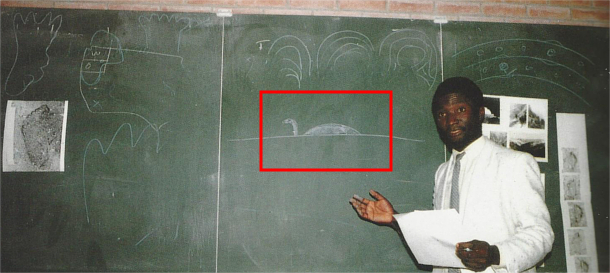
"Marcellin Agnagna shows asketch of the creature he claims to have spotted in a Congolese lake in 1983 . Camera problems prevented the biologist from brining back hard evidence, but he had no doubt that 'the animal we saw was Mokele-mbembe .'"
-Russell B. Adams, Mysterious Creatures, Time-Life Books, p. 96, ISBN: 0-8094-6332-6
The above reference is from Time-Life Books, but please don't misunderstand to think they're standing on the side of truth by printing these reports in a book, because on the very next page, they provide this quote from Roy Mackal:
"I admit that my own views are tinged with some romanticism, but certainly not to the extent that I would endure extreme hardship, even risk my life, to pursuea dream with no basis in reality ."
-Russell B. Adams, Mysterious Creatures, Time-Life Books, p. 97, ISBN: 0-8094-6332-6
The problem is that this quote is repeatedly used on the subject in many places, including Wikipedia, where it is typically used to make it seem like Roy Mackal had no interest in further pursuing Mokele-mbembe, but that's not what he meant by this. This was a statement Mackal made to show people his resolve in that he was convinced there were creatures roaming the swamps of Africa that closely resembling a living dinosaur, and that he was willing to risk his life to prove it.
"It is the overwhelming conclusion of the participants of this expedition thatsome unidentified type of animal inhabits the Lac Tele vicinity and possibly exists throughout the entire forest region of the Likouala ."
-Roy P. Mackal, A Living Dinosaur? The search for Mokele-Mbembe, Brill Archive, 1987, p. 309, ISBN: 9789004085435
Mackal's position, even as an evolutionist, is written on the back cover:
"In addition to the very full account of Mokele-mbembe, whichDr. Mackal believes could indeed be a kind of sauropod dinosaur , the book analyses reports of other still-unknown creatures inhabiting the Likouala swamps. These analyses are detailed, thorough, and provocative, leading us to conclude that there may, indeed, be several different members of the animal kingdom awaiting discovery in this vast inhospitable region."
-Roy P. Mackal, A Living Dinosaur? The search for Mokele-Mbembe, Brill Archive, 1987, back cover, ISBN: 9789004085435
The typical mainstream sources fail to point out with the "life risking" quote from Mackal that he DID risk his life in expeditions, and the only reason he could not continue searching the jungle was due to lack of funding. Many of the men who led the search for this creature have died of old age, with Mackal himself dying in 2013, and the organization they formed for cryptozoological (i.e. unknown creature) studies was disbanded.
One of the first locations we will cover is also a very famous one: Loch Ness. Many people make the mistake of calling is "Loch Ness Lake," but that's redundant because the word 'loch' means 'lake'. The Loch Ness Monster has been heard of by most people around the world to the point that some foolish directors made up some movie about it that refers to the creature in the lake as some magical, mythical monster, which only serves to entertain a crowd and make it more difficult for people to learn the truth.
(See IMDB, "The Water Horse," Dec 25, 2007, retrieved Apr 20, 2016, [imdb.com/title/tt0760329])
As a side note, the "Water Horse" is actually a part of Scotland paganism, representing a demonic shape-shifting entity. Also known as the "Kelpie," the water horse is supposed to lure in victims and then drown them in the water, and it is this kind of pagan lore that Hollywood associates with the dragon in the lake that fools people into believing the truth of a real creature is nothing more than a myth.
|
Loch Ness is a long, thin stretch of lake that is roughly 23 miles in length. The lowest points of the lake reaches about 788 feet in depth, with the water being nearly pitch black after just a few feet below the surface. The lake is very secluded, being surrounded by tall mountain ranges on all sides, and prior to 1933, anyone who desired to see the lake had to climb over the mountains, or row several miles up river. (See Encyclopaedia Britannica, "Loch Ness," retrieved Apr 20, 2016, [britannica.com/place/Loch-Ness-lake-Scotland-United-Kingdom]) In 1933, construction crews blasted a tunnel through the bottom of the mountain, creating an easy-access entrance for tourists to drive their vehicles through. It was after this tunnel was created that a number of tourists began to report sightings of a huge creature. |
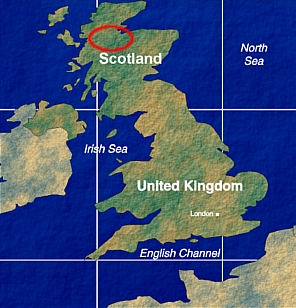 |
"Although accounts of anaquatic beast living in Scotland's Loch Ness date back 1,500 years , the modern legend of the Loch Ness Monster is born whena sighting makes local news on May 2, 1933 . The newspaper Inverness Courier related an account of a local couple who claimed to haveseen 'an enormous animal rolling and plunging on the surface .'... interest steadily grew, especially afteranother couple claimed to have seen the beast on land, crossing the shore road ."
-History, "1933: Loch Ness Monster Sighted," retrieved Apr 20, 2016, [history.com/this-day-in-history/loch-ness-monster-sighted]
Of course, the mainstream media source History, a conglomerate of evolutionists, make the whole thing seem like a giant hoax made up by the imaginations of a couple of tourists, and then further implies it was just a media stunt to gain more popularity and bring in more visitors. What they don't tell their viewers is that there were 52 separate sightings in 1933, and more started pouring in every year.
"There were52 separate sightings in 1933 alone by individuals or groups who were willing to go on record as having seen something big and unidentifiable in the loch."
Alan Landsburg, In Search of Myths and Monsters, Corgi, 1977, p. 52, ISBN: 9780552105392
In fact, there have been thousands of testimonies, both from visitors and those who live in the area, since 1933. The following author has spent much of his life studying the Loch Ness monster:
"In terms ofreports starting in 1933 that appears in books, magazines and newspapers, the total runs to about one thousand seven hundred (1,700) . Doubtless, there are others which have gone unreported. This would average out at about twenty sightings a year, but the actual numbers per year can vary enormously from over a hundred to none...There are also reports of the monster before 1933 , most of which were revealed by witnesses coming forward after 1933."
-Roland Watson (author of The Water Horses of Loch Ness), "How man times has the Moster been seen?" Loch Ness Monster, Sept 14, 2015, retrieved Apr 21, 2016, [lochnessmystery.blogspot.co.uk/2015/09/nessie-faq.html]
There are reports of a water-dwelling monster that existed in the lake and nearby river of Loch Ness that stretch back to the 8th century A.D., which is the first documented account of the creature in currently known recorded history. (i.e. This does not account for unknown, unrecorded encounters.) Adomnan of Iona recorded the life of Saint Columba, and his personal encounter (along with the encounters of the locals) with a "water beast" while crossing "the River Ness."
(See Adomnan of Iona, Life of St Columba, Penguin UK, 1995, II 27, ISBN: 9780141907413; See also Adamnanus Hiensis, Vita S. Columbae, The Carolingian Libraries of St. Gall and Reichenau, p. 74-75, retrieved Apr 21, 2016, [stgallplan.org/stgallmss/viewItem.do?pageArk=p21198-zz002b4dhk&ark=p21198-zz002b3k0s])
The typical scoffer says that all the sightings are total myths, hoaxes, or misidentified creatures, as this priest of Evolutionism asserts:
"Despite itstotal implausibility , however, the legend of Nessie persisted throughout the 20th century."
-Phil Edwards, "How scientists debunked the Loch Ness Monster," Vox Curiosites, Oct 20, 2015, retrieved Apr 21, 2016, [vox.com/2015/4/21/8459353/loch-ness-monster]
Yet, many reasonable, experienced, and highly-respected individuals have claimed to have seen Nessie. For example, Alexander Campell, game warden for Loch Ness, reported seeing the dragon 18 times in 47 years, but according to evolutionists, an experienced game warden must have just been hallucinating another animal he was too ignorant to recognize.

Sir Peter M. Scott (knighted in 1973) was a British scientist and naval officer who helped found the World Wild Fund for Nature and the Wildfowl & Wetlands Trust, was the vice-president of the British Naturalists' Association, and he received the J. Paul Getty Prize (awarded for leadership in conservation) for his accomplishments. Both Peter and his wife claimed they saw the Nessie." -International Society of Cryptozoology, The ISC Newsletter, The Society, 1989, Winter Vol. 8, No. 4 An accomplished naturalist in biology and animal conservation, who has nothing to gain by his testimony, comes forward and says he has seen the Loch Ness monster, but again, those who believe in Evolutionism will simply write him off as a confused nutcase. |
 |
Arthur Grant was a veterinarian student in 1934, and on January 5th, he almost crashed into Nessie with his motorcycle at 1:30 AM:
"I had a splendid view of the object. In fact I almost struck it with my motorcycle. The body was very hefty. I distinctly sawtwo front flippers, and there seemed to be two other flippers which were behind and which it used to spring from ... It hada long neck and large oval shaped eyes on top of a small head ."
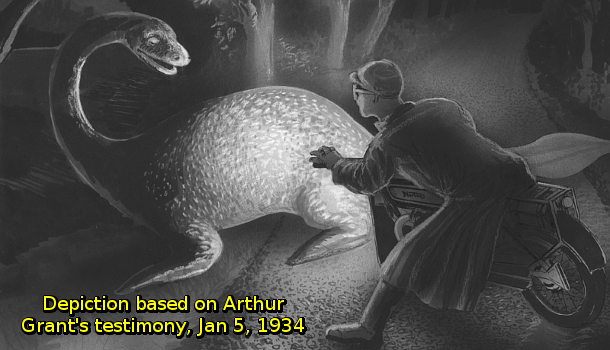
"Thetail would be from five to six feet long and very powerful ; the curious thing about it was that the end was rounded off: it did not come to a point. Thetotal length of the animal would be 15 to 20 feet . Knowing something of natural history I can say thatI have never seen anything in my life like the animal I saw . It looked like a hybrid. I jumped off my cycle and followed the animal, which had entered the loch with great speed. There was a huge splash and from the disturbance of the surface it had evidently made away before I reached the shore."
-Arthur Grant, quoted by The Lincoln Star, "Survivors of a Lost World?" Lincoln, Nebraska, Mar 18, 1934, p. 35; See also New York Times, "Scotch Student Says He Met Sea Monster While Motorcycling on Loch Ness Shores," Jan 6, 1934, p. 10, retrieved Apr 21, 2016, [query.nytimes.com/gst/abstract.html?res=9906E5D9103DE33ABC4E53DFB766838F629EDE]
This is Arthur Grant's personal sketch of what he said he saw that night:
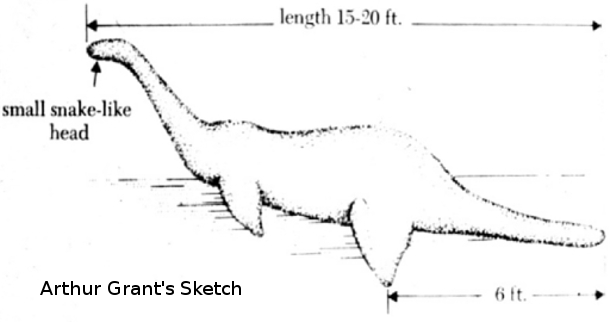
These sightings have been taken seriously by some scientists and researchers because the people seeing the creature (or creatures) have no connection to one another, come from different time periods (over decades and centuries), and the descriptions are coming back almost exactly the same. Certainly there have been a number of fakes and frauds, but again, that does not mean we ought to throw out legitimate accounts, but sadly, many people do simply because they have been blinded by Evolutionism.
In Feb 28, 1960, Torquil McLeod testified that he saw Nessie, and watched it through binoculars for almost ten minlutes. The following is McLeod's sketch of what he saw:

On Aug 20, 1952, Greta Finlay sketched what she saw in Loch Ness. She said what she saw had strange antenna-like horns on its head, which could indicate a male/female differentiation.
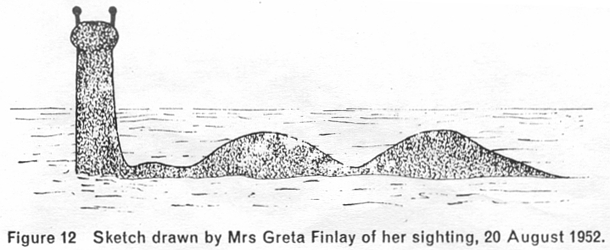
In 1987, Operation Deepscan took place, which was a fleet of fishing boats attached with echosounder equipment that swept across the length of Loch Ness hoping to find sonar scans of Nessie. Although the plan seemed solid, there are some serious flaws.

"In a project known as Operation Deepscan,twenty-four sonar-equipped boats swept much of the twenty-four-mile length of Loch Ness in October 1987 , creating a sonar curtain that no moving object could escape. While no definite evidence of Nessie was unconvered, some researchers claimengine noise would have driven such a creature into hiding ."
-Russell B. Adams, Mysterious Creatures, Time-Life Books, p. 88, ISBN: 0-8094-6332-6)
So the first problem is that 24 engines come roaring down the stretch of Loch Ness, with sonar broadcasting into the depths, which any water-dwelling creature is going to be very sensitive to detecting. Any water dwelling animal that could get away from the sound would swim into hiding immediately at the unknown blasts of sound that carry very easily in water, many miles away.
The other problem that often goes unnoted is that after the boats scanned the lake, they came back with a topographical map (i.e. physical features of an area) of the bottom of Loch Ness, which had never been done before.
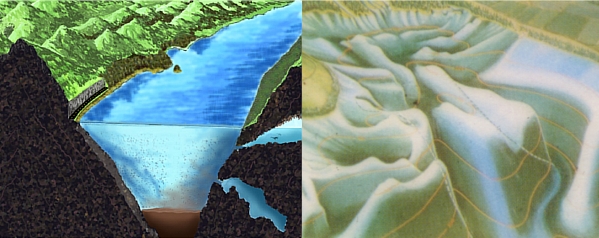
In 1972, the Academy of Applied Science and the Loch Ness Investigation Bureus setup motion sensor cameras at the bottom of Loch Ness, and took these photos. These photos are enhanced from their original to better see the outlines of the object; the second photo (right) was taken 45 seconds after the first (left).
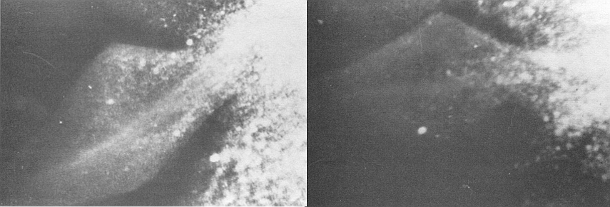
One of the best photos I've ever seen of Nessie is the one developed by Peter O'Connor as he waded into the water close enough to take this shot, and let me say before we go any further, I fully understand the intense criticism that has been brought against O'Connor over this photograph. Obviously, the skeptics claim this is a fake, but I've seen arguments from both sides, and I happen to think this is a credible photo.
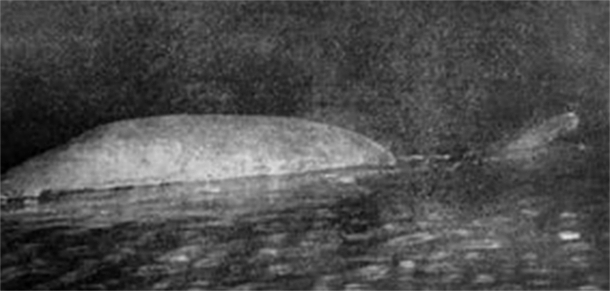
The arguments against this photo have to do with the lighting because Peter O'Connor said he took this photo between 0600 and 0630 on May 27th, 1960, and skeptics have pointed out that there is some daylight out at that time, so they believe O'Connor is lying about the time or the photo, which destroys its credibility. However, there are a few factors the evolutionist scoffers refuse to consider:
|
"Dinsdale has told me that his subsequentomission of the photo resulted from O'Conner's attitude : upset by public criticism and ridicule and charges of fakery,O'Connor wanted to be left in peace. Dinsdale remains inclined to believe that the photo could really be of a Nessie ."
-Henry H. Bauer, The Enigma of Loch Ness: Making Sense of a Mystery, Wipf and Stock Publishers, 2012, p. 73-74, ISBN: 9781620322314
Tim Dinsdale, in his book Loch Ness Monster, gave a very reasonable answer to the scoffers over the lighting of the photo:
"This is a reasonable question, but there is a perfectly simple answer to it, and it is vital that it should be understood. Asevery photographer knows , the human eye and a camera are not the same thing at all, anda scene that may appear fairly bright to the eye can be as black as pitch to the film in a camera, if the settings are wrong . Correct film exposure is dependent primarily on three things—shutter speed, lens aperture [opening or hole], and film emulsion speed. If the aperture is too small for a given light intensity, the film will appear under exposed, or black. Now,Peter O'Connor's small and inexpensive camera was set at an absurdly small aperture, f.14 , for the limited intensity of light one could expect at this time of year at 6.30 a.m. I know this is so because I took dozens of light meter readings at about the same time in the morning a few weeks before the event, on the shore of Loch Ness; in conditions which, to my own eye, seemed bright enough, and I know that for the combination of film and shutter speed at his camera,an aperture of f.14 was completely inadequate; and that the film would, in consequence, be grossly under exposed . I took some pictures myself in 'perfect visibility' at about this time at f.2.8 which is a far larger aperture—and the results are barely discernible. The reason why the human eye is so deceiving in terms of judging actual light intensity, is because it is such a marvellous automatic mechanism. The iris of the eye opens wide when light is poor giving the maximum light to reach the retina. The result is that the observer remains unconscious of even large degrees of changing light intensity—whereas the camera aperture is fixed at whatever setting is chosen. Andif this is too small the film gets too little light and the image appears dark or black ."
-Tim Dinsdale, Loch Ness Monster, Routledge & Kegan Paul, 1982, ISBN: 9780710090225
The photo above is the first of two photos O'Conner took. The first photo he used flash, and the second photo he did not. (The second photo turned out completely black.) It was obvious that, even though there was some daylight out, he was concerned whether the flash might ruin the photo, so he took a second one without it, which many of us have done with our own cameras, but sadly, he didn't know his low aperture setting on the camera would cause the pictures to come out so dark.
The real reason O'Conner got firebombed so badly in the media is because his photo is strong evidence of a plesiosaur-like dinosaur swimming in the water. Again, the existence of dragons today would be a huge upset to the Evolutionism dogma.
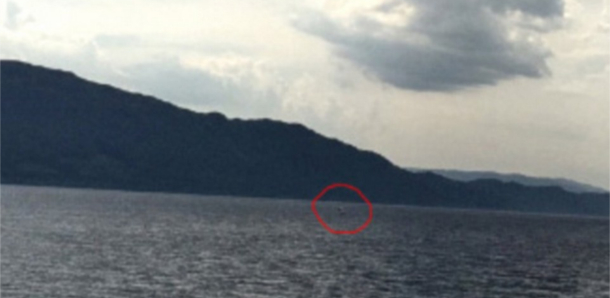
"American tourist Crystal Ardito... recently found pictures of 'Nessie' after studying her summer holiday snaps. 'I went to Scotland to go on the Loch Ness boat ride on July 1. I took photos of the loch and I was just looking at my photos and I found one photo where I saw a grey thing sticking out of the water, so I zoomed in,' she said. Ms Ardito said she had only seen the object for 'a few seconds' and 'did not notice the grey object in the photo until months later ,'"
-Joseph Curtis, "New sightings of Loch Ness Monster at their highest in more than a decade with five unexplained eye witness accounts of the mythical beast in the last year," Daily Mail, Dec 7, 2015, retrieved May 6, 2016, [dailymail.co.uk/news/article-3349535/New-sightings-Loch-Ness-Monster-highest-decade.html]; Image from same source.
These two photographs were submitted to the Falmouth Packet in 1976 by a woman who did not want her full name published, and that's understandable considering how much harassment, libel, and slander come from simply documenting what you see in the water. "Mary F" took these photos near Trefusis Point, which is located west of the English Channel, which was about 18ft long, as she stated in her cover letter. She described the creature she saw:"It looked like an elephant waving its trunk, but the trunk was |
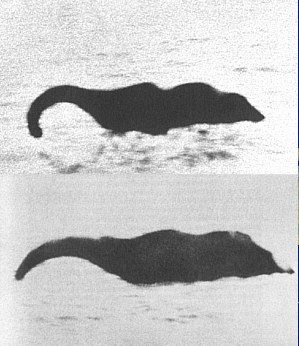 |
A Mr. H. Hodgson drew this sketch of a creature he reported seeing in the English Channel:
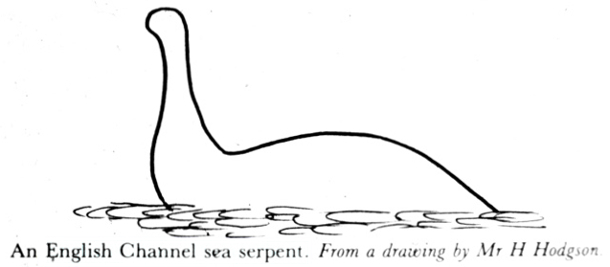
|
I found it fascinating looking up older versions of dictionaries prior to the 20th century. The definition of "Sea Dragon" reads as follows in 19th century dictionaries:
Though a strange description, it does match somewhat to the description of the Leviathan we mentioned earlier, and it seems that many people were reporting sightings of such strange creatures throughout many past centuries, but the number of documented sightings has increased more in the 20th century due to the frequency of easy-accessible media sources and transportation. Sadly, due to the harassment and jeering from evolutionists in the past few decades, many people have become more afraid of reporting what they have seen. |
Canada has a number of monsters seen in different lakes around the country, with thousands of eye-witnesses and counting. One of them is called the "Ogopogo," that lives in Okanagan Lake in British Columbia, about 20 miles north of the Canadian/Washington State border:
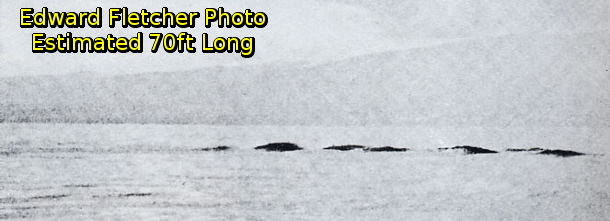
"Edward Fletcher of Vancouver, Canada, hastily shut off the engine of his high-speed runabout on August 3, 1976, to avoid colliding with 'a garter snake blown up to 70 feet long .'... They were encountering the phenomenon called 'Ogopogo,' North America's version of the Loch Ness monster. Fletcher stared at one four-foot hump as it passed , then raced back to shor for a camera. Back in the water, spotting 'a strange wave' of the kind reported many times at Westbank, Fletcher shut off his engine and took photographs... Eleven months later, Erin Neely came too close to Ogopogo and went into shock. On July 2, 1977,she was waterskiing, saw ogopogo as she approached it, dropped her towline and fell flat in the water ."
-Mary Moon, "Ogopogo, Canada's lake monster: oft seen, never snared," Smithsonian Magazine, Vol. 9, Issue 8, November, 1978, p. 173
The following was published in the Kelowna Daily Courier in August of 2000. The eye-witness was swimming near Rattlesnake Island, which is said by locals to be the 'hot spot' for Ogopogo sightings:
"Daryl Ellis has a whale of a fish tale. And he's glad the fish got away. Ellis completed a marathon swim Tuesday from Penticton to Vernon...While swimming past Rattlesnake Island near Peachland, Ellis saw two large, swimming creatures. He has no idea what they were. 'For the first few days people didn't believe me. I saw what I saw,' said Ellis. 'There were two of them. It was about eight feet below me in the water. It was about20-30 feet long .' The second creature was smaller and both kept pace with Ellis for some distance. 'These wereblackish-grey . There was something there,' he said. The creatures frightened Ellis and he headed to the support boat and told driver Wayne Muirhead he wanted to get out. He didn't tell Muirhead what he saw andhis friend convinced him to stay in the water because he was making good time. Ellis started swimming again and noticed he still had company. 'They just kind of wanted to follow me along,' he said. 'There was no way I could shake them.' Ellis said the creatures did not try to harm him, but because of their size and the fact he didn't know what they were, he was nervous. He again had an encounter of the unexplained near the floating bridge. 'The second time was much clearer whenthis big eye came up and took a look at me ,' he said. Ellis didn't see any humps, which has been associated with Ogopogo, butthe eye was the size of a grapefruit and was about nine metres from him. 'The front part of it was big.' Ellis didn't tell people immediately because he was worried people might think he was spinning a yarn. "
-Daily Courier Staff, "Lake swimmer has fish tale," Delowna Daily Courier, British Columbia, Aug 25, 2000
The article goes on to give some evolutionist scoffing remarks about the sighting, claiming it was just a big sturgeon, but local fisherman responded that there are no sturgeon in those waters. In fact, according to the article published in the local newspaper, there's never been a recorded catch of a sturgeon in that lake, and even if that were the case, the largest recorded sturgeon ever caught was the rare albino strugeon that was about 11 feet, which is much smaller than what Ellis described.
(See David Strege, "Rare albino sturgeon, possibly the world�s biggest, caught on Fraser River," Grind TV, Oct 30, 2015, retrieved Apr 27, 2016, [grindtv.com/fishing/rare-albino-sturgeon-possibly-the-worlds-biggest-caught-on-fraser-river/#IjEc0E9S6UxIOTAJ.97])
Canadian newspaper The Province published a local woman's claim that she's seen the Ogopogo on two separate occasions:
 |
"When Debbie Gelter first saw |
"Around 7:30 p.m. on Tuesday, Gelter was again on the balcony when her daughter Alesha, 12, threw her brother Josh's big blue ball into the lake. 'She went out there on her air mattress to get it and this thing appeared. I was yelling at her to come back and I heard this splash, splash, splash,' said Gelter. 'The first thing my son said was, "Does he eat kids?"...It looked shy and smart -- but in the same breath, stupid ,' she added. 'I was reluctant to talk, but I know what I saw ."
-David Wylle, "I saw Ogopogo twice, woman says: Vernon mom spots fabled beast swimming in Okanagan Lake," The Province, June 6, 2004, p. A10
A local newspaper reporter and author (and a TV crew separately) was interviewed by the New York Times about Ogopogo:

"'I know something exists,' Mrs. Gaal, a local newspaper reporter, said at her home. 'There have been hundreds of sightings, too many to be explained away by any other cause ,'... A guide for the Nippon TV crew, which was here in 1990 and returned in 1991, she said they had had at leastthree close encounters with Ogopogo, one that she herself witnessed : a strange turbulence in the waters of Lake Okanagan and then 'something that looked like ahuge serpent moving slowly, turning in large circles .' Don Defty, the driver of one of the cars for the Japanese, who now works as a scriptwriter and used to be vice president of the local film association, confirmed Mrs. Gaal's account. 'We were on our way to Peachland and Rattlesnake Island where Ogopogo is supposed to make his home,' Mr. Defty recalled. 'We were on a bluff [i.e. a hill/cliff without trees]. Youcould see 30 to 40 feet away, under the water. It was large and looked like it had something like flippers .'... interest never dies, and has just been revived by publicity surrounding a paper that two marine researchers will present to the prestigious joint annual meeting of the American and Canadian Societies of Zoology in Vancouver on Dec. 27-29 [1992]. The paper says 'evidence strongly supports' recognition of a ' very large marine cryptid ' in coastal British Columbia as a 'distinct vertebrate species ' probablyrelated not only to Ogopogo but to other 'well-known aquatic cryptids of deep northern lakes such as the Loch Ness .'"
-Clyde H. Farnsworth, "Kelowna Journal; Nessie's Canadian Cousin: Scientists Are Believers," The New York Times, Dec 2, 1992, retrieved Apr 27, 2016, [nytimes.com/1992/12/02/world/kelowna-journal-nessie-s-canadian-cousin-scientists-are-believers.html]
The two scientists mentioned above, oceanograher Paul Leblond who worked for the University of British Columbia, and zoologist Edward Bousfield who worked for the National Museum of Natural Sciences in Ottawa, also did an anaylsis of the eye-witness testimonies concerning the Cadborosaurus (or Caddy) sighted in Cadboro Bay, about 40 miles northwest of Seattle, Washington:
"Their paper deduces thatCaddy is 40 to 50 feet long as an adult, 10 to 15 feet long as a juvenile, has flippers, inhabits deep water, but comes to shallower areas to mate , and 'embodies major characteristics of both Reptilia and Mammalia, but is not clearly classifiable within existing subcategories of either.'"
-Clyde H. Farnsworth, "Kelowna Journal; Nessie's Canadian Cousin: Scientists Are Believers," The New York Times, Dec 2, 1992, retrieved Apr 27, 2016, [nytimes.com/1992/12/02/world/kelowna-journal-nessie-s-canadian-cousin-scientists-are-believers.html]
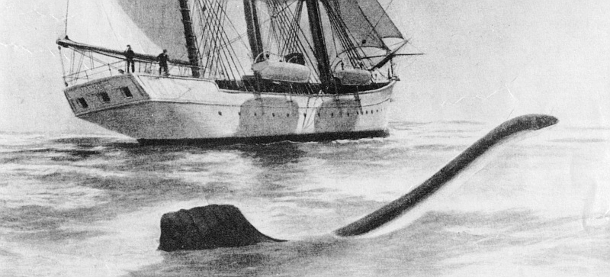
"In 1905 observers on the yacht Valhalla, cruising of the coast of Brazil spotted adorsal fin about six feet long and two feet high. Then a small head on a neck about seven or eight feet long rose in front of the fin . The creatures color was mainly dark brown, turning white on the underside of the neck, and a 'good-sized' body could be seen under the water... the observers weretwo experienced British naturalists , Michael J. Nicoll and E.G.B. Meade-Waldo,Fellows of the Zoological Society ."
-Matthew A. Bille, Rumors of Existence: Newly Discovered, Supposedly Extinct, and Unconfirmed Inhabitants of the Animal Kingdom, Hancock House, 1995, p. 127, ISBN: 9780888393357
In 1929, Arthur Doyle, author of the famous Sherlock Holmes novels, and his wife said they spotted a creature that looked exactly like a plesiosaur off the coast of Aegina, Greece:
"I saw, swimming parallel to the ship, under water, a curious creature around -Arthur C. Doyle, quoted by Harold T. Wilkins, Secret Cities of Old South America, Cosimo Inc, 2008, p. 326, ISBN: 9781605203218 |
 |
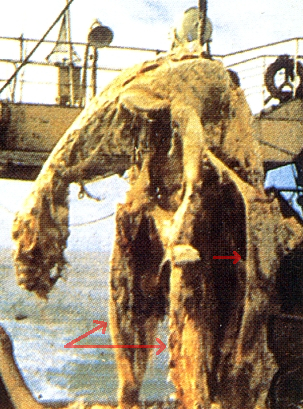 |
In 1977, a Japanese fishing boat (Zuiyo Maru) pulled up this creature off the coast of Christchurch, New Zealand. I am fully aware that scoffers of Evolutionism have claimed this is just a basking shark decaying, and I looked at their arguments with an open mind. I am still not 100% convinced this is a basking shark for a number of reasons, but the bottom line is that both sides of this argument are speculating, and no one knows for sure what it was.
The two main flippers in the front are very distinctive in the photo, but the third one (indicated by the red arrow on the right side) is what has made this creature unique. The evolutionist will claim that this flipper is actually a dorsal fin of a shark that's wrapped around, but the testimony of the fisherman, and of the sketches made by Michihiko Yano, a section chief for Taiyo Fishery Company, which show a horizontal tail, not a vertical one like sharks normally have. |
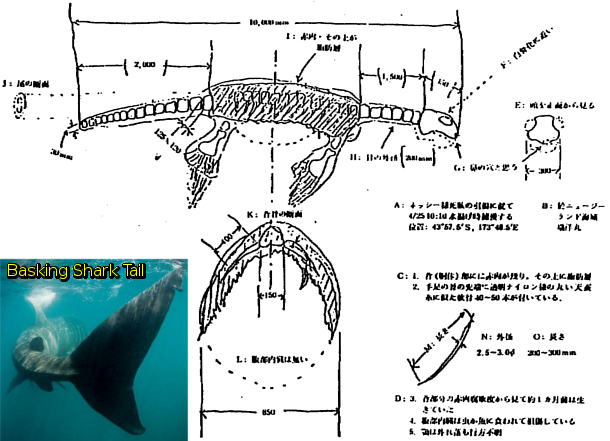
"The limb bones shown in Yano's drawing wereevidently based on presumption or pro-plesiosaur bias rather than observation ."
-Glen J. Kuban, "An Analysis of a Supposed Plesiosaur Carcass Netted in 1977," Reports of the National Center for Science Education, Vol. 17, No. 3, 1977, p. 16-28, retrieved Apr 22, 2016, [paleo.cc/paluxy/plesios.htm]
The problem is that Kuban hasn't observed it at all, except through a couple of photos, but finds that enough to condemn Yano of being delusional, or a liar. Kuban does make a few interesting points in his paper that indicate this may simply be a basking shark carcass, but the critique of his paper by John Goertzen also makes interesting points not discussed by Kuban. I have no idea if it was a plesiosaur or not, but I will leave a reference to Goertzen's paper as well so you can look at both for yourself and make your own educated decision.
(See John Goertzen, "New Zuiyo Maru Cryptid Observations: Strong Indications It Was a Marine Tetrapod," Creation Research Society Quarterly Journal, Vol. 38, No. 1, p. 19-29, 2001, retrieved Apr 22, 2016, [creationresearch.org/crsq/articles/38/38_1/Cryptid.htm])
As a side note, one of the arguments used to support the basking shark theory is the analysis of the protein structure samples retrieved by Yano. Even Creation Ministries Internationl (CMI) has said:
"This carcass was almost certainly a rotting basking shark... detailed anatomical andbiochemical studies [i.e. protein analysis] of the Zuiyo-maru carcass show that it could not have been a plesiosaur ."
-Jonathan Sarfati, "Moving forward: Arguments we think creationists shouldn't use," Creation Ministries International, retrieved Apr 26, 2016, [creation.com/moving-forward]
To put it simply, there was roughly a 95% match in the protein structure to shark cartilage (tissue), but the problem is that similarity does not prove it is the same creature. First of all, no one knows what plesiosaur protein is supposed to look like, so we can't draw any scientific conclusions about it unless we had a known sample, and second, we need to keep in mind that monkeys and man are claimed to have 95% similarity in DNA, but they are two separately distinct kinds, which means the protein similarity argument wouldn't have any merit even if we had confirmed plesiosaur protein samples with which to make a comparison.
(Read "The Incredible Edible DNA: Similarity Fallacy & Mitochondrial Eve" here at creationliberty.com for more details on the subject of the fallacious evolutionary argument that similarity proves common ancestry.)
It's possible it could have been a basking shark, and it's possible it could have been a plesiosaur-type creature. I don't know for sure. Whether it was or not has no bearing on the truth of the existance of these creatures documented in other photographs and by numerous eye-witness testimonies. I'll just let the reader draw his/her own conclusions about the carcass.
There have also been sightings of a creature similar to the Loch Ness monster in Lake Erie. In the 1980s, the creature was named "Bessie," and many of the sightings have been on the southwest end, east of Toledo, Ohio:
"TheErie Indians were the first to tell the white trappers about the monster that lived in the lake . French trappers first sighted the Lake Erie monster, later offically named Bessie, in1793 and added their stories to the Indian legends.Over the next two hundred years, the sightings continued. All the accounts describe a remarkably similar creature--somethingthirty to sixty feet long resembling a snake, with a small head and arm-like appedages or fins ."
-Betsy D'Annibale, The 1924 Tornado in Lorain and Sandusky: Deadliest in Ohio History, The History Press, 2014, p. 29, ISBN: 9781626196360
"In 1881, much excitement surrounded the capture of a'big sea serpent' in Sandusky Bay, Lake Erie ... According to the New York Times, fishermen Clifford Wilson and Francis Cogenstose of Cincinnati, were fishing in the lake when alarge marine animal measuring twenty-five feet (7.6 m) long and about twelve inches (30 cm) through the thickest part, rose from the water beside their boat. Somewhat unnerved, they whacked it over the head with an oar, knocking it senseless. Then they fastened a line to its head and towed it to shore. The creature began to revive when they reached shore. The two men obtained a packing box six feet (2 m) long, three feet (1 m) wide and approximately two feet (61 cm) deep, coiled the creature into it and nailed it tightly shut. By that time, the Times said the monster was thrashing about dangerously.Neither the 'owners' nor any of the scores of anxious onlookers would take a chance on opening the box to show the 'serpent' to skeptics. "
-Betty S. Garner, Monster! Monster!: A Survey of the North American Monster Scene, Hancock House Publishers, 1995, p. 92, ISBN: 9780888393579
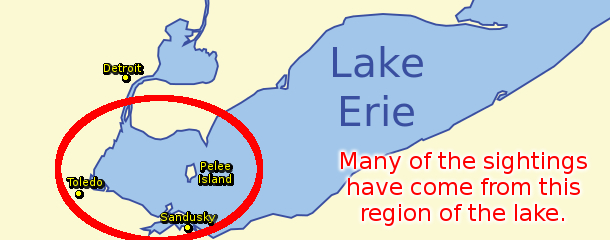
"Most reports describe Bessie as thirty to forty feet long, gray, and snake-like... One of theearliest recorded sightings of the monster occurred in 1793, when a hunter saw a seventeen-foot-long snake-like creature rising out of the water . And in1873, a group of railroad workers reported seeing a twenty-foot-long sea serpent in the lake . A few days later, somelocal farm animals vanished, and people found tracks that indicatd something had dragged the animals into the lake ...
Bessie caused another big stir in1993, when she apparently attacked a sailboat on the lake, prompting a local businessman named Tom Solberg to offer a $100,000 reward to anyone who could capture the creature safely and unharmed."
-Oliver Ho, Mutants and Monsters, Sterling Publishing Company Inc, 2008, p. 18-20, ISBN: 9781402736421
In 1990, Harold Bricker described the creature he saw swimming near his boat:
"Does Nessie, Scotland's fabled Loch Ness monster, have a cousin?A handful of sightings of huge serpentlike creatures in Lake Erie were recorded in 1985 and 1987 . But things remained quiet until Sept. 4. [1990] That's when Harold Bricker and his family returned from a fishing trip with a new sighting... The Brickers said they saw a large creature moving in the water about 1,000 feet from their boat. They described it as black, about35 feet long and with a snakelike head . The creature has since been reported by five people on three separate occasions."
-Associated Press, quoted in Lakeland Boating, Peterson Publishing Company, Vol. 46, 1991, p. 19, [University of Michigan]; See also The Info Journal, International Fortean Organization, Vol. 15, 1990, p. 29
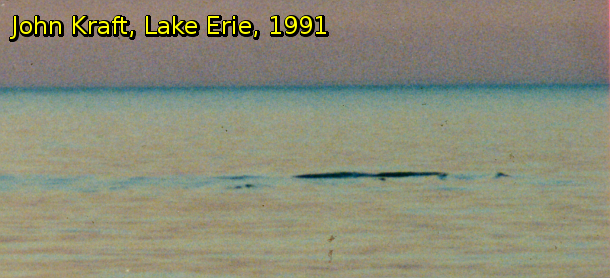
"[A]fter I had finished my picture taking I sat down with my mother-in-law, wife and my brother-in-law and about five minutes later my wife said to me, 'John, look out about 100 yards, there appears to be some men in wet suits, about 8 to 10 men swimming.' And since I had a telephoto lens on my camera, because of the sunset picture taking, I zoomed in on it andit wasn't mean in wet suits. It was, I don't know what it was, but for lack of a better name, I call it a monster fish. I could see its head and the neck went under the water; could see the top of the body and could actually see the fotilla action of the tail. "
-Rob Morphy, "Bessie: (USA - Canada)," Cryptopia, Jan 6, 2010, retrieved Apr 29, 2016, [cryptopia.us/site/2010/01/bessie-usa-canada]
|
Worse than the man lying is how many creationist organizations, including Carl Baugh himself (who bought the stuffed creature and put it up in his museum), have gone completely silent on the subject. I am unable to find any information on it whatsoever from any of the sources who actually handled it; including Pete Petersen's L&D Bait Shop, which I called to try to confirm the story, but cannot get in touch with anyone (and no one will return my calls). In addition to that, I'm not even going to bother contacting Carl Baugh's organization any more because I have tried doing that a number of times over the years to verify certain information, and each time I've called, his staff seems to be completely ignorant about anything that's involved with their museum. This is not some insult, they literally have no clue what I'm talking about, even when it comes to things displayed in their museum. Each time I've called, Baugh is always out, and never returns my calls (even though we've met before and been on the same speaking roster). Their website seems to have no information on it either. So what's really pathetic (on the side of the creationist organizations) is that I find more information coming from the evolutionist side on this topic, as we can see from this author's report: "Upon hearing of Baugh's 'find' I telephoned Petersen, whose shop happened be not far from where I lived at the time. As I inquired about the 'monster' Petersen related that -Glen J. Kuban, "Lake Erie Sea Monster?" 2007, retrieved Apr 26, 2016, [paleo.cc/paluxy/eriebaby.htm] I don't trust this evolutionist author anymore than I trust Carl Baugh on the matter, but at least he's willing to attempt to document information about it, and due to my own experience in dealing with Baugh's organization, I'll give more credit to the evolutionist author on this subject. Until Carl Baugh starts backing up what he's saying with something solid, willing to document his finds clearly for all to read, I will remain extremely cautious of his organization. Sadly, no one else is even talking about the situation in effort to help others learn the truth of the matter. I just wanted to put this section on here so that others who are researching the subject can discover that, at the very best, there is no where near enough information on this this stuffed creature to promote it as a plesiosaur sighting, and at the very worst, this taxidermist lied and Baugh paid a lot of money for a fraud. I also want to apologize to anyone who may have learned false information from our past promotion of the "Baby Erie" on our website, and I will continue to do my best in the future to clean up any bad information like that at CLE and be more accurate in my research and writing. On the other hand, as quoted above, there have been sightings of a Nessie-like creature living in lake Erie, so we don't want to throw the baby out with the bath water, or in other words, we don't want to discount all eye-witness testimonies because one man decided to lie for some extra cash. (Read "God Does Not Justify Lies" here at creationliberty.com for more details.)
For this, Thou shalt not commit adultery, Thou shalt not kill, Thou shalt not steal, Thou shalt not bear false witness, Thou shalt not covet; and if there be any other commandment, it is briefly comprehended in this saying, namely, Thou shalt love thy neighbour as thyself. |
There is also testimony of a Nessie creature in Lake Michigan:
"ThatLake Michigan is inhabited by a vast monster, part fish and part serpent, no longer admits of doubt ... As it is, the evidence of the crews [testimony] establishes the fact that the animal is betweenforty and fifty feet in length , his shape serpentine, thesize of the neck about that of a human being , and the size of his body about that of an ordinary barrel."
-Chicago Tribune, "THE LAKE MONSTER: Description of the Animal by a Fisherman," Aug 7, 1867, No. 88, p. 4, retrieved May 3, 2016, [archives.chicagotribune.com/1867/08/07/]
Vermont has had many sightings of the Lake Champlain Monster, also known as "Champ." The lake was "discovered" (which is European bias that excludes the Native Americans) by Samuel de Champlain, who also reported that he saw the creature in the water:
"The first recorded sighting of Champ dates back to July1609 , whenSamuel de Champlain claimed he saw a 20-foot serpent thick as a barrel and a head like a horse ."
-Dick Teresi, "Monster of the Tube," Discover Magazine, Apr 1, 1998, retrieved May 3, 2016, [discovermagazine.com/1998/apr/monsterofthetub1428]
The most famous photo of Champ was taken by Sandra Mansi. Many skeptics have tried to find a way to prove this photo was faked, but all tests have shown it to be authentic, and the combined testimonies matching:

"According to Mansi, her family's encounter with Champ took place on Tuesday, July 5, 1977, Sandra and her fiance, Anthony Mansi, along with Sandra's two children from a previous marriage, were taking a leisurely drive along Lake Champlain. They drove by some farmland and, around noon, made their way to a small bluff overlooking the lake. The two children went down to the water while Anthony returned to the car to get a camera. As Sandra watched her children and the lake, she noticed a disturbance in the water about 150 feet away. She thought at first that it was a school of fish, then possibly a scuba diver. 'Then the head and neck broke the surface of the water.Then I saw the head come up, then the neck, then the back .'... Mansi didn't panic: 'I wasn't even scared, I'm just trying to figure out what I'm seeing. Then when Tony came over the field he saw it and started screaming, "Get the kids out of the water!"' The kids scrambled up the bank and headed toward the car. As Anthony helped Sandra up the bank, he handed her the camera. She knelt down, snapped one photo, and then put the camera down to watch the creature. The Mansis estimated thatthe creature's neck stuck about six feet out of the water and was about twelve to fifteen feet long. The sighting lasted a remarkably long time--between five and seven minutes--during which the creature never turned to face the shore . Sandra Mansi described the neck and head as dark in color and said that what we see in the photograph is as much of the creature as she saw."
-Benjamin Radford & Joe Nickell, Lake Monster Mysteries: Investigating the World's Most Elusive Creatures, University Press of Kentucky, 2006, ISBN: 9780813136967
In addition to Mansi's amazing photo, many eye-witnesses have come forward to testify they have seen Champ:
"Throwing out the least credible sightings, a consensus appears:an animal with a snakelike body 25 to 30 feet long, with two or three humps above the waterline. The reports come from sea captains, ministers, doctors, a high school principal, a state trooper, a historian. Fifty-eight passengers celebrating a fiftieth wedding anniversary aboard the ship Spirit of Ethan Allenreported that a creature 30 to 35 feet long with three to five humps cruised with the boat about 200 feet off the port side for five minutes before making a 90-degree turn and diving.'Don't tell me it was a carp or a sturgeon,' skipper Michael Shea insists. If it was a fish, it weighed 3,000 or 5,000 pounds.' "
-Dick Teresi, "Monster of the Tube," Discover Magazine, Apr 1, 1998, retrieved May 3, 2016, [discovermagazine.com/1998/apr/monsterofthetub1428]
This creature washed up on the beach in Santa Cruz, California in 1925, and witnesses on the scene reported a bulb-shaped head connected to a long, thin neck that was about 20ft long.
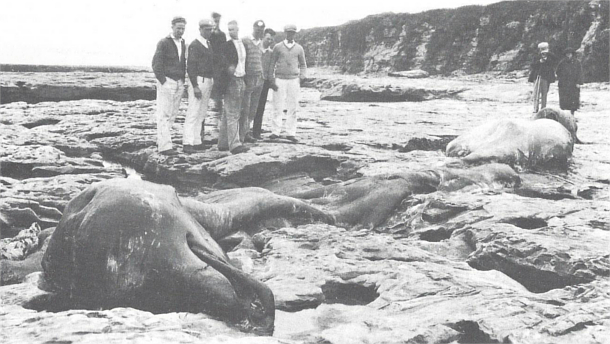
The evolutionist scoffers have simply called this a Baird's beaked whale. Below is an image of a Baird' beaked whale so you can do your own comparison:

I confess a great difficulty in finding any neck on that whale, and the head shape is completely different from the creature washed up on the beach. The image below has an outline of the head and neck of the unknown creature.

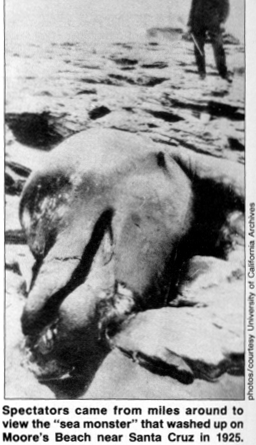 |
The president of the Natural History Society of British Columbia, E.L. Wallace, was on the scene and inspected the creature:"My examination of the monster was quite thorough. I felt in its mouth and found it had no teeth. Its head is large and its -E.L. Wallace, quoted by Randall Reinstedt, Shipwrecks and Sea Monsters of California�s Central Coast, Ghost Town Publications, 1975, p. 165, ISBN: 9780933818026 |
There are other sightings that vary in description from the plesiosaur, and fit more aptly the description of a liopleurodon. One of these is from Herr Kapitan Baron von Forstner in 1915, who was patrolling the Atlanctic with his Unterseeboot (submarine) crew, and they saw something very strange after firing a torpedo at a British freighter:
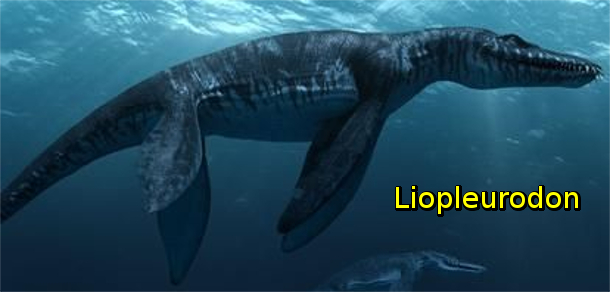
"There was a violent explosion, 25 seconds after the Iberian [i.e. British feighter] had gone under, and a few seconds later, a gigantic sea monster was hurled, writhing and struggling, around 30 yards into the air. The monster was around60 feet long, shaped like a crocodile. His head was long and pointed, and he had four legs terminating in big fins . He remained above water only around 15 seconds, so there was no time to photograph him. Three other officers saw him."
-Herr Kaptian Baron von Forstner, quoted by Harold T. Wilkins, Secret Cities of Old South America, Cosimo Inc, 2008, p. 326, ISBN: 9781605203218
Other German submarine captains that same year reported encounters with giant sea monsters with similiar description of the liopleurodon, but some had feet:
"Saw a sea serpent at 10 p.m., without possibility of doubt. The creature hada longish head, scales like a crocodile's, and legs with proper feet . The mate saw him, but when the captain came up from below, the monster had vanished. The monster was about90 feet long ."
-Kapitan Werner-Lowisch, quoted by Harold T. Wilkins, Secret Cities of Old South America, Cosimo Inc, 2008, p. 326, ISBN: 9781605203218
A dinosaur was claimed to have been sighted the locals living in Rabaul, Papau New Guinea:
"Reports a live dinosaur had been sighted on a volcanic island of Papua New Guinea prompted the deployment of heavily-armed police in search of the mystery creature... Eyewitness Christine Samei told reporters she |
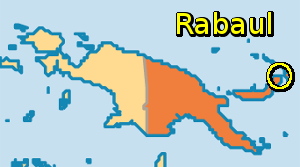 |
There are also many reports of "snake-like" creatures without any kind of neck, which very accurately fits the description of a basilosaurus. The priests of Evolutionism will fight this fervently because basilosaurus is claimed to be one of their "missing links" in the imaginary chain of evolution, which is beyond silly; we document more details on that in another article on our website.
(Read "Lies of Evolution: Basilosaurus" here at creationliberty.com for more details.)

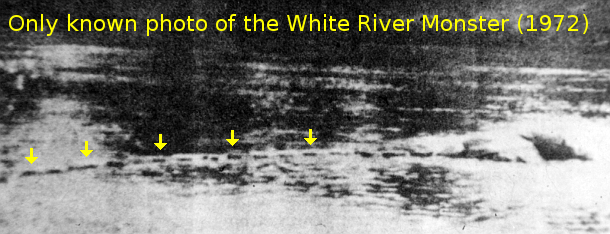
"TheWhite River Monster was spotted here many times between 1937 and 1977 . The serpentine creature has been described asgray, at least thirty feet long, with a spiny backbone visible on the surface of the water . The creature was photographed by Cloyce Warren of the White River Lumber Company on July 28, 1971. In 1973 a resolution was passed by theArkansas legislature creating the White River Monster Refuge and making it illegal to 'molest, kill, trample, or harm the White River Monster while he is in the retreat.' "
-Dennis William Hauck, Haunted Places: The National Directory, Penguin, 2002, p. 26, ISBN: 9780142002346
The rotting carcass of this creature washed up on Pukehina beach in New Zealand. The following video was posted by Elizabeth Ann in May of 2013, showing a striking similarity to a basilosaurus:
Five teenagers went diving off the coast of Pensacola, Flordia in March of 1962, but only one came back alive. Edward McCleary was the sole survivor of an encounter with a plesiosaurus that ate his four friends:
"I can only describe it as a high-pitched whine. We panicked. All five of us put on our fins and went into the water. 'Keep together and try for the ship,' I yelled. After we were in the water we became split up in the fog. From behind I could hear the screams of my comrades one by one. I got a closer look at the thing just before my last friend went under. Theneck was about 12 feet long , brownish-green and smooth looking. Thehead was like that of a sea-turtle except more elongated, with teeth [and] there appeared to be what looked like a dorsal fin when it dove under for the last time. Also, as best I am able to recall, theeyes were green with oval pupils ."
-Edward B. McCleary, quoted by Tim Dinsdale, Monster Hunt, Acropolis Books, 1972, p. 92, [University of Virginia]
The reason this story is hard to document is because the newspapers omitted McCleary's testimony of what happened to his friends, reporting instead that the young men drowned, and though this may be confusing to some people, please consider that Florida, espeically areas like Pensacola, are tourism hot spots where people come to vacation and swim in the ocean. This means you have a lot of businesses along the coast, and if the newspapers reported that a sea monster was eating divers, tourists would find somewhere else to go, and local businesses would have a difficult time keeping their doors open.
Also, McCleary did not want to tell his story after his initial report, and as far as I heard, went into heavy drinking to try and drown the images out of his mind. After going through alcohol rehab programs, he refuses to talk to anyone about it today (even though he still lives in Pensacola), and the following author tracked down a few more details of his original account:
"I don't know how long it was before we heard a scream. It lasted maybe half a minute. Then I heard Warren call, 'Hey! Help me! It's got Brad! I've got to get outta here!' His voice was cut off abruptly by a short cry. 'Brad, Warren. Hey! Where is everybody?' I yelled back at the top of my lungs. Larry now swam with Eric and me. Warren and Brad were nowhere in sight.Right next to Eric that telephone pole-like figure broke water. I could see the long neck and two small eyes. The mouth opened and it bent over. It dove on top of Eric, dragging him under. I screamed and began to swim past the ship. My insides were shaking uncontrollably. I finally made it to the ship, the top of which protruded from the water, and stayed there for most of the night, early that morning I swam to shore and was found by the rescue unit."
-Edward B. McCleary, quoted by Frank Spaeth, Mysteries and Monsters of the Sea, Gramercy Books, 2001, p. 105, ISBN: 9780517163498
The pterosaur (pterodactyl) is quite commonplace in some regions of Africa, being more commonly known as the "kongamato" or "batamzinga." The word "kongamato" means "overwhelmer of boats" because there is a saying in Africa that if someone in a canoe sees a kongamato, they're already dead because it tips their boat over and eats the people.
In 1923, Frank Melland was working in Zambia, and listened to the testimony about kongamato from the natives, but he wanted to see if he could get a more accurate description:
"I sent for two books which I had at my house, containingpictures of pterodactyls, and every native present immediately and unhesitatingly picked it out and identified it as a kongamato . Among the natives who did so was a headman (Kanyinga) from the Jiundu country, where the kongamato is supposed to be active, and who is a rather wild and quite unsophisticated native."
-Frank Melland, quoted by Jerome Clark, Encyclopedia of Strange and Unexplained Physical Phenomena, Gale Research Incorporated, 1993, p. 265, ISBN: 9780810388437
This author gives a few more details of Melland's experience:
"[Melland] kept coming upon rather vague rumours about a much feared animal called Kongamato said to live in the Jiundu swamps in the north west corner of Northern Rhodesia, near the frontier of the Belgian Congo and Angola. He asked what it was. The natives told him that -Bernard Heuvelmans, On the Track of Unknown Animals, Routledge, 2014, p. 584, ISBN: 9781317848127 |
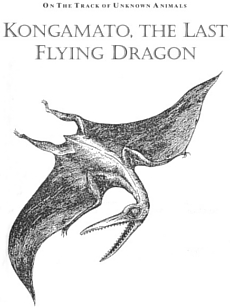 |
The pterodactyl has even been seen in the U.S. The following author documents an Arizona newspaper in 1886, and the testimony of two local ranchers:
"Awinged monster resembling a huge alligator with an extremely elongated tail and an immense pair of wings was found on the desert between Whetstone and Hauchuca Mountains last Sunday by two ranchers, as they returned home from the Huachucas. The creature was evidently greatly exhausted by a long flight and when discovered was able to fly but a short distance at a time. After the first shock of wild amazement had passed, the two men, who were on horseback and armed with Winchester rifles, regained sufficient courage to pursue the monster and after an exciting chase of several miles, succeeded in getting near enough to open fire and wound it. The creature then turned on the men but owing to its exhausted condition they were able to keep out of its way and after a few well directed shots the monster rolled partly over and remained motionless."
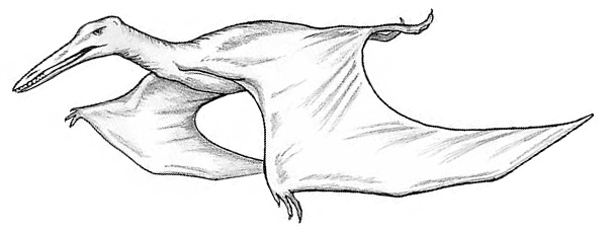
"The men cautiously approached, their horses snorting with terror, and found that the creature was dead. They proceeded to make an examination and found thatit measured ninety-two feet (28 m) in length and the greatest diameter was about fifty inches (127 cm). It had only two feet, situated a short distance in front of where the wings were joined to the body. The back as near as they could judge, was about eight feet (w.4 m) long. The jaws were thickly set with strong, sharp teeth. The eyes were as large as dinner plates and protruuded from the head. Some difficulty was encountered in measureing the wings as they were partly folded under the body. But finally one was straightened out sufficiently to get a measurement of seventy-five feet (23 m), making the total length from tip to tip about 160 feet (49 m).
Thewings are composed of a thick and nearly transparent membrane and are devoid of feathers or hair, as is the entire body. The skin of the body was comparatively smoth and easily penetrated by a bullet . The men cut off a small portion of the tip of one wing and took it home with them. Last night one of them arrived in this city for supplies and to make preparations to skin the creature. The hide will be sent to eminent scientists for examination. The finders returned to the kill early this morning, accompanied by several prominent men who will endeavor to bring the strange creature to town before it is mutilated."
-The Epitaph, Tombstone, AZ, quoted by Betty S. Garner, Monster! Monster! A Survey of the North American Monster Scene, Hancock House Publishers, 1995, p. 46-47, ISBN: 9780888393579
It's unknown if any scientists got to examine the creature, but the report matches exactly that of a gigantic pterodactyl. This isn't the only sighting of pterodactyls in the U.S.
Another frightening story broke out of Washington in 1890; the location of the incident being the east side of the Cascade Mountains. Multiple newspapers reported the story of three travelers at Lake Chelan, one of which stepped into the lake to take a bath, and a creature grabbed him by the foot:
"[W]hat was their surprise to see the monster also emerge from the water firmly attached to the man's leg by its teeth. It was a horrid looking creature, with thelegs and body of an alligator and the head and restless eye of a serpent. Between its fore and hind legs, on either side, were large, ribbed feathery looking wings. The tail was scaled but not barbed like that in the picture of the typical dragon . With the exception of the under part of the throat and the tips of the wings, feet and tail, thecreature was a beautiful white and its skin as soft as velvet. Knives, sticks and stones and everything else which were brought to bear upon the monster proved unavailing, and at last the ingenious travelers bethought themselves of heroic measure. They built a good fire and pulled the neck and belly of the beast, bird, or fish, across it, taking good care not to burn the leg of their comrade in the operation. After a while the scorching heat aroused the animal from its torpor. It began to move its body and to stretch out its leathery wings after the manner of a bat, and suddenly flew into the air, still holding the man by the leg. After rising to a height of about 200 feet (61 m) it took a 'header' downward toward the lake, into which it plunged with a splash, burying itself and victim out of sight."
-Arkansas City Daily Traveler, May 11, 1890, p. 7, retrieved May 7, 2016, [newspapers.com/newspage/53219201]; See also Mattoon Gazette, Mattoon, Illinois, Feb 14, 1890, p. 3
In 1976, Patricia Bryant, a school teacher in San Antonio, Texas, is one of many people who saw more than one giant flying pterodactyl gliding around town:
"Teacher Patricia Bryant says the two creatures that swooped over her car were as big as small airplanes and resembled prehistoric birds. Mrs. Bryant was one of three teachers, who reported the latest sightings of 'Big Bird,' a large, feathered creature reportedly seen throughout South Texas in recent months. Scientists identified one of the birds seen recently as a blue heron. But Mrs. Bryant is sure the one she saw looked prehistoric. She said an encyclopedia identified the creature as a pteranodon. 'It was the biggest thing I've ever seen alive, particularly flying. My Lord,it (pteranodons) lived like 160 million years ago, it's just unreal ,' she said. 'Where did it come from? I just don't knowhow it could have survived all those millions of years and still be flying around here . Its enough of a shock to see one. Then to discover there were two is really frightening. It all happened so fast and it was such a shock you think you are seeing things. It was just enormous and frightening. I told my husband it was as big as a Piper Cub [single-engine airplane] and he just laughed at me. I thinkthe wing span was 15 or 20 feet if not more .'"
-Boca Raton News, "It Was No Robin," Feb 26, 1976, p. 2A
No matter what you believe about the testimonies of all these people, the absurdity is that evolutionists would have you believe that all these people are just idiots, hallucinating, or they're all in some big conspiracy against Evolutionism. The fact is that there are far too many eye-witness accounts, all from different times, and locations, to ignore the fact that there are still dinosaurs/dragons alive today.
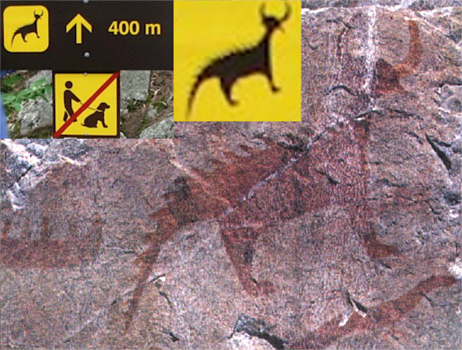
Skeptics have claimed this horned creature was just an oarfish, but the Huffington Post reported on a dead oarfish that washed up on the beach in California in 2015. The structure of the two bodies is completely different, from head to tail. Compare the two and see if you believe the oarfish explanation that evolutionist scoffers attempt to provide.
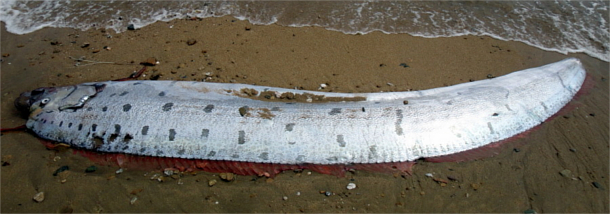
Evidence of a large sea monster's activity was accidentally discovered by marine scientiests:
"[S]cientists have been tagging larger sharks in order to keep track of them in the ocean... Some of these scientists stumbled upon a sea monster when they tagged a healthy 9-foot great white shark only to find the tracking device washed upon the beach four months later. The data from the device showeda rapid temperature rise combined with a plunge of 1,900 feet down into the ocean deep . The device moved around in that location for several days before eventually making its way to shore. The researchers hypothesized that asuper predator swallowed the great white shark and then swam down to its normal habitat to lurk . They believe thetemperature spike indicates the device was inside the sea monster's digestive tract ."
-Patrick Frye, "Great White Shark: Attack by Sea Monster Swallows 'Small' Shark, Is It The Bible's Leviathan?" Inquisitr, retrieved May 6, 2016, [inquisitr.com/1286977/great-white-shark-attack-by-sea-monster-swallows-small-shark-is-it-the-bibles-leviathan-video]; See also "Hunt For The Super Predator," Smithsonian Channel, May 30, 2014, retrieved May 6, 2016, [youtube.com/watch?v=Z_QyGANCUJI]
This strangely-shaped creature washed up on the coast of Sakhalin Island, Russia in June of 2015:
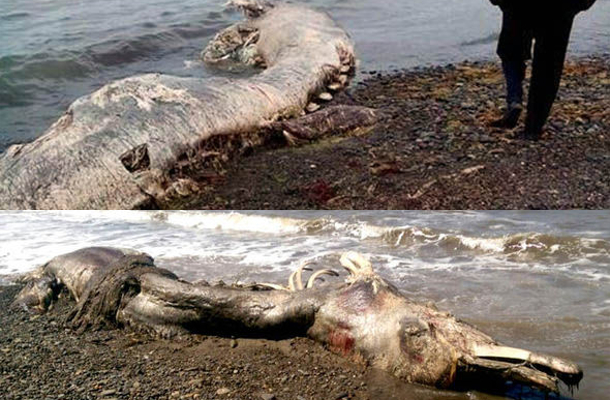
"The remains of agiant sea creature with a bird-like "beak" and fur on its tail have been washed up on a remote Russian beach. Scientists have yet to identify the strange prehistoric-like 'mutant', which has similarities to a dolphin but is twice as large as a human being."
-Will Stewart & Tom Batchelor, "Mysterious GIANT furry sea creature found washed up on Russian beach," Express June 30, 2015, retrieved Mar 25, 2016, [express.co.uk/news/world/587954/Giant-sea-creature-Russia-beak-fur-mutant-Sakhalin-Island]
This news publication provided a close-up picture of the tail with hair on it. Notice also there is no fin where a dolphin would normally have one.
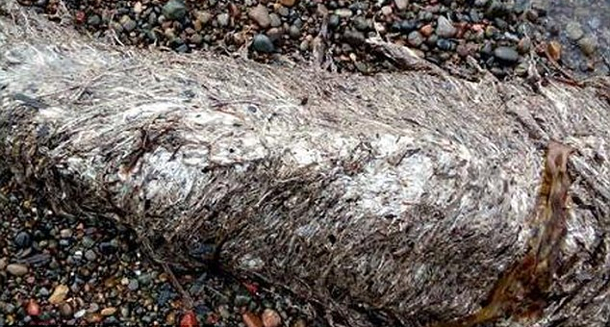
The article interviews an oceanographer who says it's just a dolphin, but she confesses that dolphins don't have fur, even though she continues to insist its just a dolphin. What people need to understand about the "science" business, is if you proclaim something to be a sea monster of unknown origin or relation to any already known "species" verified by the mainstream, you will get laughed at and ridiculed out of academia, which will make it almost impossible to find a job in your field. Even though the creature does not look like any dolphin I've seen alive or dead, it's twice the size of an average dolphin, and it has fur on it, the woman still insists that its a dolphin, and the secret truth is that they typically do that to protect their own jobs. (i.e. If real scientific open-mindedness is brought into the church of Evolutionism, people get fired.)
(Read "Excommunicated by the Church of Evolutionism" here at creationliberty.com for more details.)
Something even more details washed up on the beach in the Philippines, a creature they called the "Hairy Globster," which fromt he video taken of the creature shows a long neck and flippers with lots of long hair. This is not the first time this type of long-necked hairy creature has washed up on their shores, but evolutionists continue to insist it is "just a whale."
![Hairy Globster Sea Monster Phillipines [creationliberty.com]](../images/dino100.jpg)
![Hairy Globster Sea Monster Phillipines [creationliberty.com]](../images/dino101.jpg)
This creature was photographed in Barmouth, Wales by Mohammad Tahla in January 2016. It was estimated to be about 30ft long. The typical "it's-just-a-log" explanation doesn't work because you can see the form of it shifting between the two pictures, and it's moving if you compare its position next to the archways in the background:
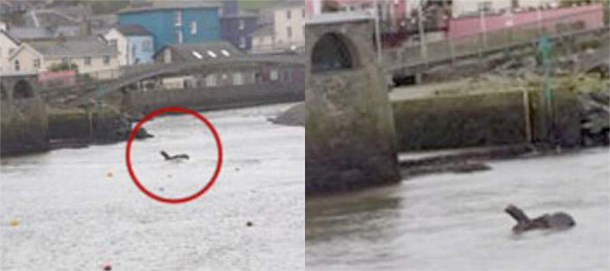
"This image of a mystery creature could be the first photographic evidence that a sea monster rumoured to roam British waters is real... Mohammad Tahla snapped the 'monster-like shape' in the estuary of the River Aeron, 60 miles away from Barmouth, sparking speculation that the Barmouth Monster has migrated south. Mr Tahla said: 'I took one look and thought "Blimey, that looks just like the Loch Ness Monster ",' he told the Cambrian News."
-Zoie O'Brien, "Is this the Barmouth Monster? Giant creature measuring 30ft spotted in British estuary," Express, Jan 14, 2016, retrieved May 6, 2016, [express.co.uk/news/weird/634280/Barmouth-Monster-Giant-creature-measuring-30ft-spotted-in-British-estuary]; Image from same source.
I will do my best to keep information here up to date with more recent findings. If anyone reading this finds legitmate discoveries, has photos, or has personal testimony of seeing strange creatures like what you've seen in this article, go to our contact page and write us about it. Make sure to include names, places, descriptions, dimensions, and any other specific details so I can reference everything as accurately as possible.
|
|
No. Sadly, many church-goers have given people the impression that if we show people evidence, they "come to Jesus," which is not the case, and the reason they can't see the error in that is because many of them do not know how people are born again.
Paul explains this to us in more detail in Galatians 3:
Wherefore the law was our schoolmaster to bring us unto Christ, that we might be justified by faith.
-Galatians 3:24
(Read "Is Repentance Part of Salvation?" here at creationliberty.com for more details; most pastors and evangelists teach have no clue what repentance means in Scripture and they teach false doctrine as a result.)
Notice Paul did NOT say that evidence was the schoolmaster that brings us unto Christ, that we might be justified by our own minds. Again, this issue is not about evidence; it's about faith, and in order to come to that faith, they need to be given repentance to the acknowledge the truth by the hearing of the law.
In meekness instructing those that oppose themselves; if God peradventure will give them repentance to the acknowledging of the truth;
-2 Timothy 2:25
But before faith came [i.e. before we were saved], we were kept under the law, shut up unto the faith which should afterwards be revealed.
-Galatians 3:23
So then faith cometh by hearing, and hearing by the word of God.
-Romans 10:17
Please feel free to share and use this article as needed, but for Christians, please don't consider the topic of dinosaurs a replacement for sound doctrine on salvation. Consider the Lord Jesus Christ did not start his ministry by preaching about dinosaurs, nor did he start out preaching faith, which is afterwards revealed, but he started out preaching repentance:
From that time Jesus began to preach, and to say, Repent: for the kingdom of heaven is at hand.
-Matthew 4:17
And he called unto him the twelve, and began to send them forth by two and two... And they went out, and preached that men should repent.
-Matthew 6:7-12












![There is No Saving Grace Without Repentance [creationliberty.com]](../images/store13a.jpg)
![Why Christians Should Study The King James Bible [creationliberty.com]](../images/store15a.png)
![Wolves in Costume: Kent Hovind [creationliberty.com]](../images/store11a.jpg)
![Corruptions of Christianity: Seventh-day Adventism [creationliberty.com]](../images/store09a.png)
![501c3: The Devil's Church [creationliberty.com]](../images/store07a.jpg)
![Feminism: Castrating America [creationliberty.com]](../images/store04a.jpg)




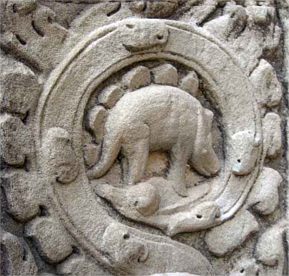
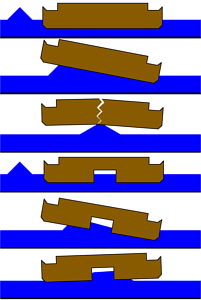
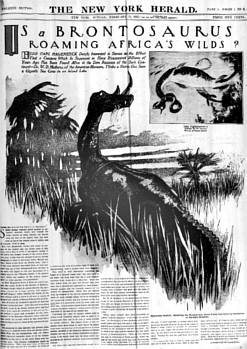

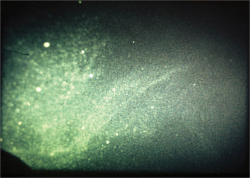
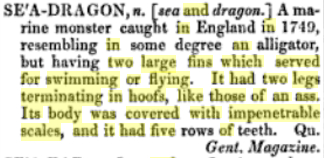
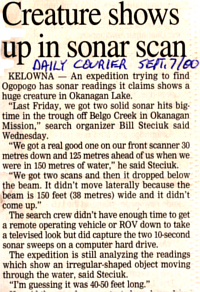
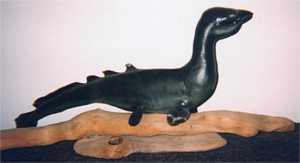
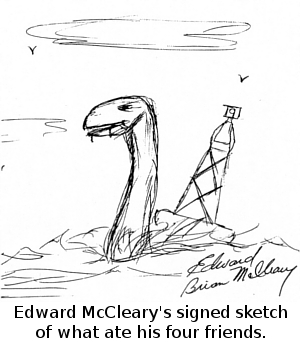
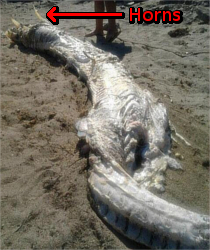







![Why Millions of Believers on Jesus Are Going to Hell [creationliberty.com]](images/store05a.jpg)
![Corruptions of Christianity: Catholicism [creationliberty.com]](http://www.creationliberty.com/images/store14a.jpg)
![False Prophet Profiles: Kim Clement [creationliberty.com]](http://www.creationliberty.com/images/store12a.jpg)
![Christmas: Rejecting Jesus [creationliberty.com]](http://www.creationliberty.com/images/store10a.jpg)
![Christian Music: For The Love of Money [creationliberty.com]](images/store08a.png)
![Psychology: Hoodwinked by the Devil [creationliberty.com]](images/store06a.jpg)
